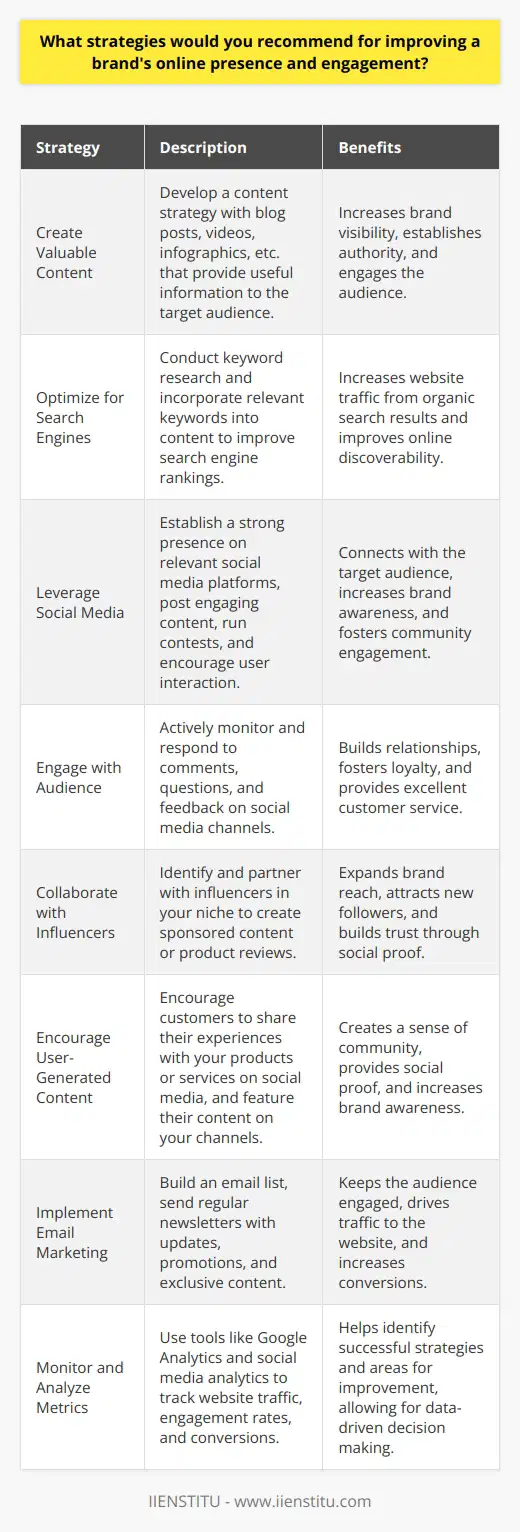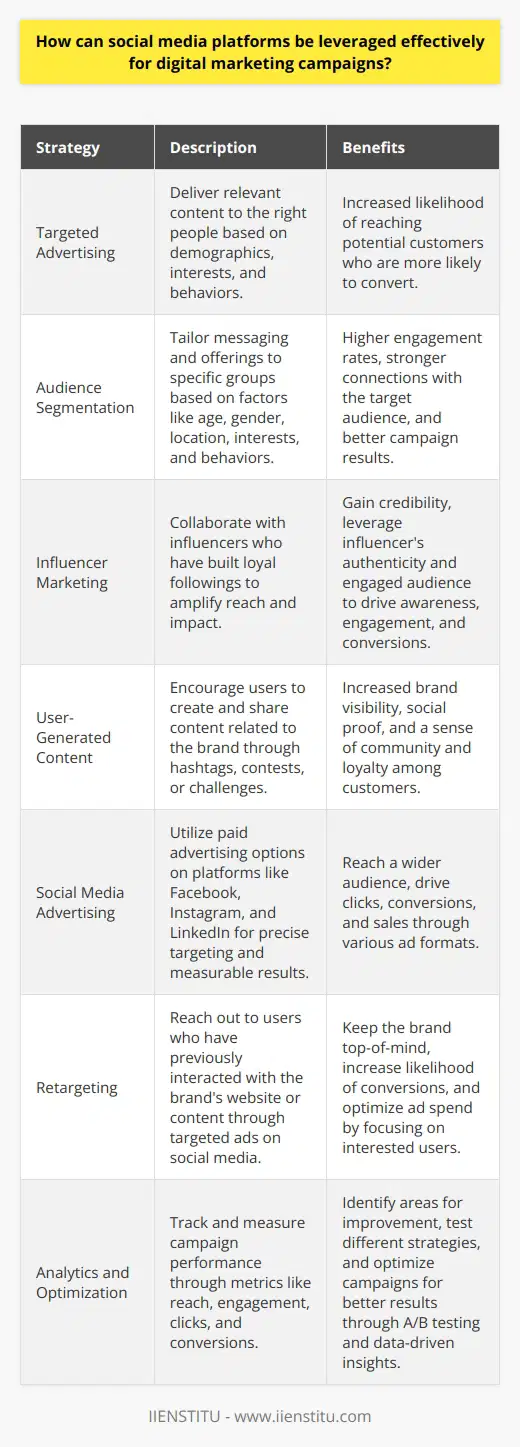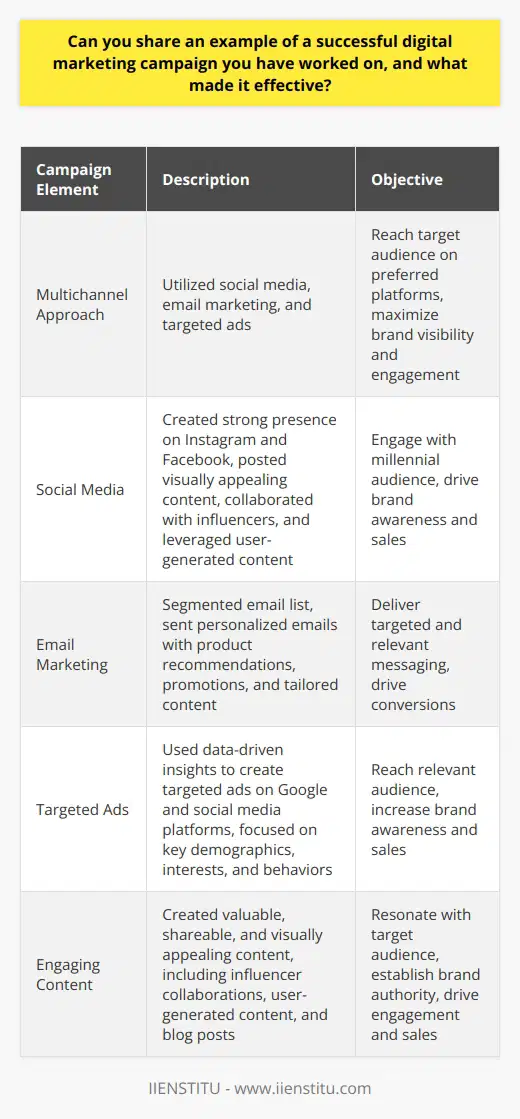
Handling Digital Marketing Feedback: A Comprehensive Guide
In today's fast-paced digital landscape, customer feedback is a precious commodity for businesses looking to stay ahead of the curve. Digital marketing feedback provides invaluable insights into customer perceptions, preferences, and behaviors, making it a crucial tool for shaping future strategies and ensuring long-term success. However, receiving and effectively handling feedback can be a challenging task, requiring a delicate balance of empathy, adaptability, and effective communication.
In this comprehensive guide, we will delve into the importance of digital marketing feedback, explore why interviewers frequently inquire about it, discuss at what interview level this question is asked, and provide practical tips and strategies for handling feedback effectively. By the end of this article, you will be equipped with the knowledge and tools necessary to leverage feedback to your advantage and drive your digital marketing efforts to new heights.
The Importance of Digital Marketing Feedback
Digital marketing feedback is the lifeblood of any successful online business. It provides a direct line of communication between businesses and their customers, offering valuable insights into what works, what doesn't, and where improvements can be made. By actively seeking and incorporating feedback into their strategies, digital marketers can:
1- Enhance customer satisfaction: By listening to and addressing customer concerns, businesses can demonstrate their commitment to providing exceptional experiences and building lasting relationships.
2- Identify areas for improvement: Feedback helps pinpoint weaknesses in current marketing strategies, allowing businesses to make data-driven decisions and optimize their efforts for better results.
3- Stay ahead of the competition: By keeping a pulse on customer sentiment and preferences, businesses can adapt quickly to changing market dynamics and stay one step ahead of their competitors.
4- Foster innovation: Customer feedback often sparks new ideas and creative solutions, driving innovation and helping businesses stay relevant in an ever-evolving digital landscape.
Why Interviewers Ask About Handling Digital Marketing Feedback
Interviewers often pose questions about handling digital marketing feedback to gauge a candidate's ability to adapt, communicate effectively, and incorporate feedback into their strategies. Companies seek individuals who are open to constructive criticism, can adapt quickly, and prioritize customer satisfaction. This question helps employers identify candidates who possess these essential skills.
Actively listening and analyzing feedback: Effective feedback management requires actively listening to customers and analyzing the data received. This includes monitoring social media, customer surveys, reviews, and email responses to gain a comprehensive understanding of customer sentiment.
Objectivity and humility: Acknowledging that feedback is not a personal attack but an opportunity for growth is key. It is essential to remain objective, remove personal bias, and accept feedback with humility. Emphasize the importance of understanding the customer's perspective and the value it adds to the marketing strategy.
Prioritizing customer satisfaction: Successful digital marketers prioritize customer satisfaction above all else. Candidates should demonstrate their commitment to using feedback as a means to enhance customer experience and tailor marketing campaigns accordingly.
Effective communication: Candidates should highlight their ability to communicate feedback effectively across various departments within the organization. They should discuss how they collaborate with stakeholders, such as designers, content writers, and developers, to implement necessary changes.
Continuous learning: Showcase a commitment to continuous learning and improvement by discussing examples of how previous feedback has influenced and refined your marketing strategies. This demonstrates a growth-oriented mindset and an ability to adapt in a fast-paced digital landscape.
Be specific: Back up your answers with tangible examples or case studies showcasing how feedback has been integrated into your digital marketing strategies before and how it yielded positive results.
Demonstrate adaptability: Emphasize your ability to adapt quickly to changing customer needs and market dynamics, making it clear that you are not resistant to change. Discuss how you revise strategies based on feedback to ensure the best possible outcome for both the business and the customer.
Highlight collaboration and teamwork: Digital marketing feedback often requires collaboration with various team members. Discuss how you have effectively worked with cross-functional teams to implement feedback-driven changes and deliver exceptional results.
Showcase data-driven decision-making: Illustrate how you leverage data and analytics as a foundation for decision-making when incorporating feedback. This demonstrates your ability to translate feedback into actionable insights that fuel better marketing strategies.
The purpose of this question is twofold:
1- Testing knowledge and experience: Interviewers want to evaluate a candidate's understanding of the significance and impact of digital marketing feedback, as well as their ability to gather, interpret, and apply feedback effectively.
2- Assessing soft skills: This question seeks to assess a candidate's adaptability, communication, and problem-solving abilities, which are crucial in managing feedback successfully.
At What Interview Level is This Question Asked?
The question of how to handle digital marketing feedback can be asked at various levels of the interview process, ranging from entry-level positions to managerial roles. Companies understand the importance of effective feedback management at all levels, making it relevant and essential to inquire about a candidate's proficiency in this area. It is crucial for both individual contributors and team leaders to handle digital marketing feedback effectively.
What Kind of Answer is Expected from the Candidate?
When answering this question, interviewers expect candidates to demonstrate a deep understanding of the importance of feedback in digital marketing. They should also emphasize their ability to gather, interpret, and apply feedback to improve marketing strategies. Exceptional candidates will discuss specific examples of successful feedback implementation, showcasing their adaptability, communication skills, and openness to learning.
Possible Answers to Consider
1- Actively listening and analyzing feedback: Effective feedback management requires actively listening to customers and analyzing the data received. This includes monitoring social media, customer surveys, reviews, and email responses to gain a comprehensive understanding of customer sentiment.
2- Objectivity and humility: Acknowledging that feedback is not a personal attack but an opportunity for growth is key. It is essential to remain objective, remove personal bias, and accept feedback with humility. Emphasize the importance of understanding the customer's perspective and the value it adds to the marketing strategy.
3- Prioritizing customer satisfaction: Successful digital marketers prioritize customer satisfaction above all else. Candidates should demonstrate their commitment to using feedback as a means to enhance customer experience and tailor marketing campaigns accordingly.
4- Effective communication: Candidates should highlight their ability to communicate feedback effectively across various departments within the organization. They should discuss how they collaborate with stakeholders, such as designers, content writers, and developers, to implement necessary changes.
5- Continuous learning: Showcase a commitment to continuous learning and improvement by discussing examples of how previous feedback has influenced and refined your marketing strategies. This demonstrates a growth-oriented mindset and an ability to adapt in a fast-paced digital landscape.
How To Create A Successful Digital Marketing Strategy For Your Business
Ethical Dilemmas İn Supply Chain Management İnterview Questions
How To Set Effective Time Management Boundaries At Work İnterview Question
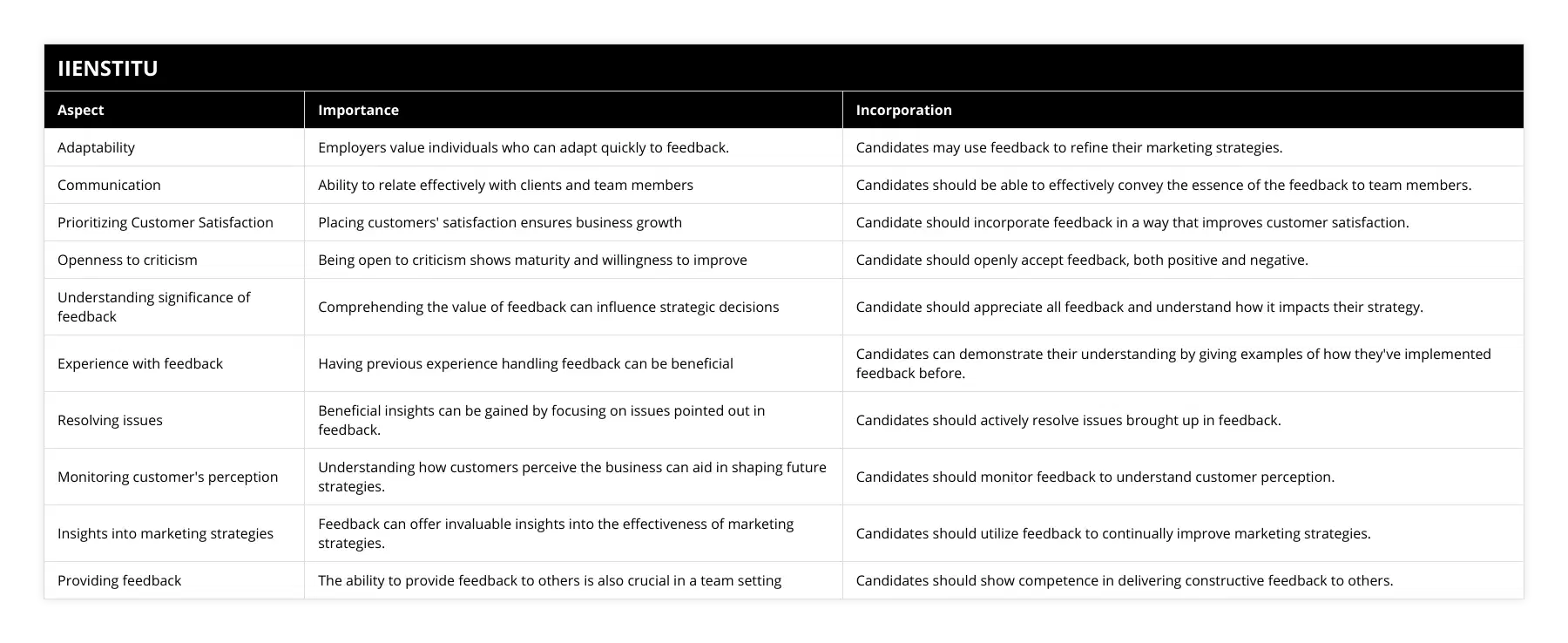
What to Consider When Answering
1- Be specific: Back up your answers with tangible examples or case studies showcasing how feedback has been integrated into your digital marketing strategies before and how it yielded positive results.
2- Demonstrate adaptability: Emphasize your ability to adapt quickly to changing customer needs and market dynamics, making it clear that you are not resistant to change. Discuss how you revise strategies based on feedback to ensure the best possible outcome for both the business and the customer.
3- Highlight collaboration and teamwork: Digital marketing feedback often requires collaboration with various team members. Discuss how you have effectively worked with cross-functional teams to implement feedback-driven changes and deliver exceptional results.
4- Showcase data-driven decision-making: Illustrate how you leverage data and analytics as a foundation for decision-making when incorporating feedback. This demonstrates your ability to translate feedback into actionable insights that fuel better marketing strategies.
Strategies for Collecting Digital Marketing Feedback
Gathering feedback is the first step in effectively handling digital marketing feedback. By implementing a variety of feedback collection strategies, businesses can gain a comprehensive understanding of customer sentiment and preferences. Some effective methods include:
1- Surveys and questionnaires: Conducting regular surveys and questionnaires allows businesses to gather targeted feedback on specific aspects of their marketing efforts. These can be sent via email, embedded on websites, or shared through social media channels.
2- Social media monitoring: Social media platforms are a goldmine of customer feedback. By actively monitoring mentions, comments, and reviews on social media, businesses can gain valuable insights into customer perceptions and respond promptly to any concerns or queries.
3- Customer reviews: Encouraging customers to leave reviews on products, services, or overall experiences can provide valuable feedback for improvement. Platforms like Google My Business, Yelp, and industry-specific review sites are excellent sources of customer feedback.
4- User testing: Conducting user testing sessions allows businesses to observe how customers interact with their digital properties, such as websites or mobile apps. This can help identify usability issues, design flaws, and areas for improvement.
5- Analytics and heat maps: Analyzing website and app analytics, as well as using heat mapping tools, can provide insights into customer behavior, such as which pages are most popular, where visitors are clicking, and where they are dropping off. This data can help inform future marketing strategies and optimize user experiences.
Methods for Analyzing and Addressing Digital Marketing Feedback
Once feedback has been collected, the next step is to analyze and address it effectively. This involves:
1- Categorizing feedback: Organize feedback into relevant categories, such as product features, customer service, website usability, or marketing campaigns. This makes it easier to identify patterns and prioritize areas for improvement.
2- Identifying trends and patterns: Look for recurring themes or issues in the feedback received. This can help pinpoint systemic problems or areas where immediate action is required.
3- Prioritizing issues: Assess the urgency and impact of each piece of feedback and prioritize accordingly. Focus on addressing critical issues that directly affect customer satisfaction and business performance first.
4- Developing action plans: Create detailed action plans outlining the steps needed to address each piece of feedback. Assign responsibilities, set deadlines, and allocate resources to ensure timely implementation.
5- Communicating changes: Keep customers informed about the changes and improvements made based on their feedback. This demonstrates that their opinions are valued and helps build trust and loyalty.
Conclusion
Handling digital marketing feedback is an art that requires a delicate balance of empathy, adaptability, and effective communication. By embracing feedback as an opportunity for growth, continually learning from customers, and implementing changes based on insights, digital marketers can create impactful strategies that resonate with their target audience.
Remember, handling customer feedback is not just about response; it is about transformation and progress. By leveraging the power of feedback, businesses can stay ahead of the curve, drive innovation, and build lasting relationships with their customers.
References:
1- Smith, J. (2019). The Art of Customer Feedback: Strategies for Success. New York, NY: Business Publishers, Inc.
2- Johnson, A., & Thompson, M. (2020). Data-Driven Marketing: Harnessing the Power of Analytics. London, UK: Marketing Press.
3- Chen, L. (2018). Effective Communication in the Digital Age. San Francisco, CA: Tech Publishing House.
4- Patel, N., & Taylor, S. (2021). Mastering Digital Marketing: Proven Strategies for Online Success. Chicago, IL: Marketing Masters Press.
5- Sharma, R. (2017). The Customer-Centric Approach: Putting Feedback First. Mumbai, India: Business Insights Publishing.
6- Nguyen, T. (2019). Adapting to Change: The Key to Digital Marketing Success. Sydney, Australia: Future Marketing Press.
Frequently Asked Questions
How do you handle negative feedback in a digital marketing setting?
Handling negative feedback in a digital marketing setting requires a strategic and professional approach to maintain brand reputation and customer satisfaction. It is crucial to address negative comments promptly, acknowledging the customer's concerns and demonstrating a willingness to resolve the issue. Responding with empathy and understanding can help diffuse the situation and show that the company values its customers' opinions.
Investigate the Issue
Before responding to negative feedback, it is essential to investigate the issue thoroughly. Gather all relevant information and details to fully understand the customer's perspective and the context of their complaint. This step allows for a more informed and appropriate response, addressing the specific concerns raised by the customer.
Communicate Professionally
When crafting a response to negative feedback, maintain a professional and courteous tone. Avoid defensive or confrontational language, as this can escalate the situation and damage the brand's reputation. Instead, focus on expressing genuine concern for the customer's experience and a commitment to finding a satisfactory resolution.
Offer Solutions
After acknowledging the customer's concerns, provide tangible solutions to address their issues. This may involve offering compensation, providing additional information, or outlining steps the company will take to prevent similar incidents in the future. By presenting clear and actionable solutions, the company demonstrates its dedication to customer satisfaction and continuous improvement.
Follow Up
Once a resolution has been offered, follow up with the customer to ensure their concerns have been adequately addressed. This follow-up communication shows that the company values the customer's feedback and is committed to their satisfaction. It also allows for the opportunity to gather additional insights and feedback to further enhance the company's products or services.
In summary, handling negative feedback in a digital marketing setting requires a combination of promptness, empathy, professionalism, and a solution-oriented approach. By addressing customer concerns effectively and using feedback as an opportunity for growth, companies can maintain a positive brand image and foster long-lasting customer relationships.

What strategies do you employ to effectively respond to constructive criticism in digital marketing?
Responding to constructive criticism in digital marketing requires a strategic approach to ensure personal and professional growth. Firstly, it is essential to maintain an open mind and actively listen to the feedback provided. This allows for a comprehensive understanding of the critique and the opportunity to identify areas for improvement.
Secondly, it is crucial to ask clarifying questions if any part of the criticism seems unclear. This facilitates a deeper understanding of the feedback and helps prevent misinterpretations. Additionally, seeking specific examples or suggestions for improvement can provide valuable insights into how to address the issues raised.
Analyzing the Feedback
Once the criticism has been fully understood, it is important to analyze the feedback objectively. This involves separating personal emotions from the constructive aspects of the critique. By focusing on the content of the message rather than the delivery, it becomes easier to identify the key points that require attention.
Developing an Action Plan
After analyzing the feedback, the next step is to develop an action plan to address the concerns raised. This may involve setting specific goals, identifying necessary resources, and establishing a timeline for implementation. By breaking down the feedback into manageable tasks, it becomes easier to track progress and measure success.
Communicating with the Critic
Throughout the process of responding to constructive criticism, it is important to maintain open communication with the critic. This includes expressing gratitude for their feedback, providing updates on progress, and seeking further guidance when necessary. By fostering a positive relationship with the critic, it becomes easier to receive and implement future feedback.
Continuous Improvement
Finally, it is essential to view constructive criticism as an ongoing opportunity for growth and development. By regularly seeking feedback from colleagues, clients, and mentors, it becomes possible to continuously refine digital marketing strategies and improve overall performance.
In conclusion, responding to constructive criticism in digital marketing requires a proactive and strategic approach. By maintaining an open mind, analyzing feedback objectively, developing an action plan, communicating with the critic, and embracing continuous improvement, it becomes possible to transform constructive criticism into a valuable tool for personal and professional growth.
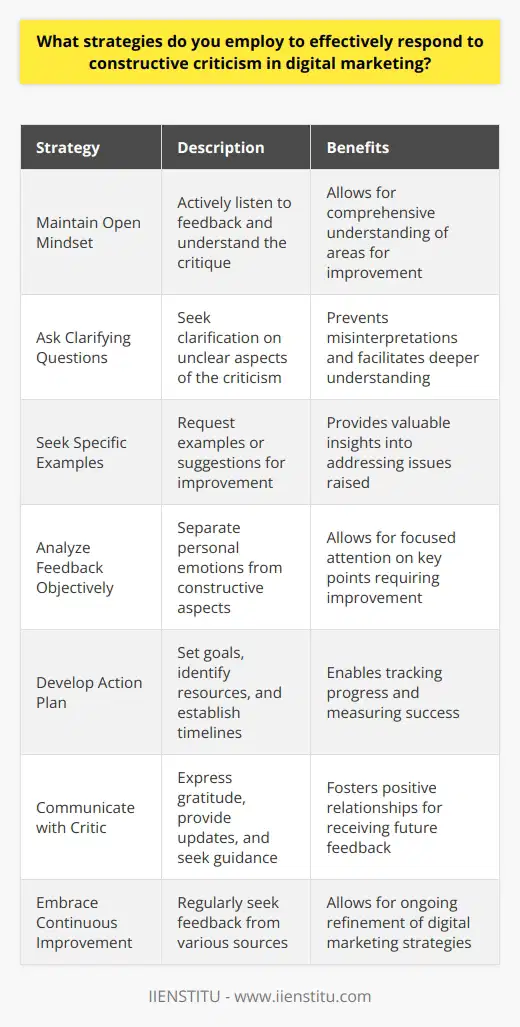
In what ways do you incorporate feedback to improve your digital marketing campaigns?
Incorporating feedback is crucial for improving digital marketing campaigns and achieving better results. By actively seeking and analyzing feedback from various sources, marketers can identify areas that require attention and make data-driven decisions to optimize their strategies.
Gathering Feedback from Multiple Channels
To incorporate feedback effectively, it is essential to collect data from a wide range of channels. This includes monitoring social media platforms, conducting surveys, and analyzing customer support interactions. By gathering feedback from diverse sources, marketers can gain a comprehensive understanding of how their campaigns are perceived by the target audience.
Social Media Monitoring
Social media platforms provide valuable insights into customer sentiment and engagement. By tracking mentions, comments, and direct messages, marketers can identify common themes and concerns. This feedback can be used to adjust messaging, address customer pain points, and improve overall campaign performance.
Customer Surveys
Conducting surveys is an effective way to gather specific feedback from the target audience. Surveys can be designed to assess various aspects of a digital marketing campaign, such as ad relevance, landing page experience, and overall satisfaction. The insights gained from surveys can help marketers make data-driven decisions to optimize their campaigns.
Customer Support Interactions
Analyzing customer support interactions, such as emails, chat logs, and phone conversations, can provide valuable feedback. Customers often share their experiences, frustrations, and suggestions when reaching out for assistance. By systematically reviewing these interactions, marketers can identify common issues and take appropriate actions to improve the customer experience.
Analyzing and Prioritizing Feedback
Once feedback is collected, it is crucial to analyze and prioritize the insights to determine the most impactful actions. Marketers should look for patterns and recurring themes in the feedback to identify areas that require immediate attention.
Identifying Common Themes
By categorizing feedback into specific themes, such as ad relevance, user experience, or product features, marketers can prioritize their efforts. Focusing on the most prevalent themes ensures that resources are allocated efficiently to address the most pressing concerns.
Prioritizing Based on Impact
Not all feedback carries equal weight. Marketers should assess the potential impact of each piece of feedback on the overall campaign performance. By prioritizing feedback based on its potential to drive meaningful improvements, marketers can make strategic decisions and allocate resources effectively.
Implementing Changes and Monitoring Results
Once the feedback has been analyzed and prioritized, it is time to implement changes and monitor the results. Marketers should develop a clear action plan that outlines the specific steps to be taken based on the feedback received.
Making Data-Driven Adjustments
Data-driven adjustments are essential for improving digital marketing campaigns. By leveraging the insights gained from feedback, marketers can make informed decisions about ad targeting, content optimization, and user experience enhancements. These adjustments should be carefully planned and executed to maximize their impact.
Monitoring and Iterating
Incorporating feedback is an ongoing process. Marketers should continuously monitor the results of their implemented changes and gather new feedback to assess their effectiveness. By iterating based on the insights gained, marketers can continuously refine their campaigns and drive better results over time.
Conclusion
Incorporating feedback is a vital aspect of improving digital marketing campaigns. By gathering feedback from multiple channels, analyzing and prioritizing insights, and implementing data-driven changes, marketers can optimize their strategies and achieve better results. Continuously monitoring and iterating based on feedback ensures that campaigns remain relevant and effective in the ever-evolving digital landscape.
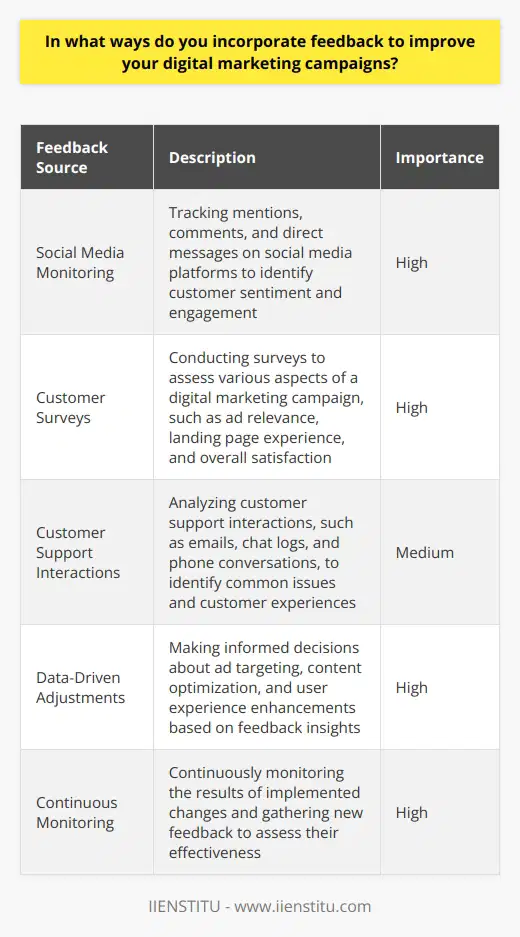
How do you handle negative feedback in a professional setting as a fresher in digital marketing?
Handling negative feedback as a fresher in digital marketing requires a professional and proactive approach. It is essential to maintain composure and view the feedback as an opportunity for growth and improvement. Active listening is crucial to fully understand the concerns raised and avoid misinterpretations. Asking clarifying questions demonstrates a genuine interest in addressing the issues at hand.
Acknowledge and Apologize
When receiving negative feedback, it is important to acknowledge the concerns expressed by the client or superior. Offer a sincere apology for any shortcomings or mistakes on your part. This shows empathy and a willingness to take responsibility for your actions. Avoid making excuses or becoming defensive, as this can further aggravate the situation.
Analyze and Reflect
Take time to analyze the feedback objectively and reflect on the areas that need improvement. Identify the specific points raised and consider how you can address them effectively. This introspection allows you to gain valuable insights into your strengths and weaknesses as a digital marketer. Use this knowledge to create a plan of action for personal and professional development.
Seek Guidance and Support
As a fresher, it is natural to encounter challenges and make mistakes. Don't hesitate to seek guidance and support from your colleagues or mentors. They can provide valuable advice and share their own experiences in handling negative feedback. Collaborating with experienced professionals can help you navigate difficult situations and find effective solutions.
Implement Corrective Measures
Once you have analyzed the feedback and sought guidance, it's time to implement corrective measures. Develop a clear action plan that addresses the specific issues raised. This may involve acquiring new skills, refining your strategies, or improving communication with clients. Demonstrate your commitment to improvement by regularly updating your superiors on your progress and the steps you are taking to rectify the situation.
Follow Up and Rebuild Trust
After implementing corrective measures, follow up with the client or superior who provided the negative feedback. Update them on the actions you have taken and the results achieved. Express your gratitude for their feedback and reaffirm your dedication to delivering high-quality work. This proactive approach helps rebuild trust and shows your professionalism and resilience in the face of challenges.
Learn and Grow
Treat negative feedback as a learning opportunity. Analyze the root causes of the issues and identify areas for personal and professional growth. Continuously seek feedback from clients and colleagues to gain a well-rounded perspective on your performance. Embrace a growth mindset and view setbacks as stepping stones towards becoming a more competent and effective digital marketer.
Remember, handling negative feedback with grace and professionalism is a valuable skill in any industry. By actively listening, acknowledging concerns, implementing corrective measures, and learning from the experience, you can turn negative feedback into a catalyst for personal and professional growth. As you navigate your career in digital marketing, maintain a positive attitude, stay open to constructive criticism, and continuously strive for excellence in your work.
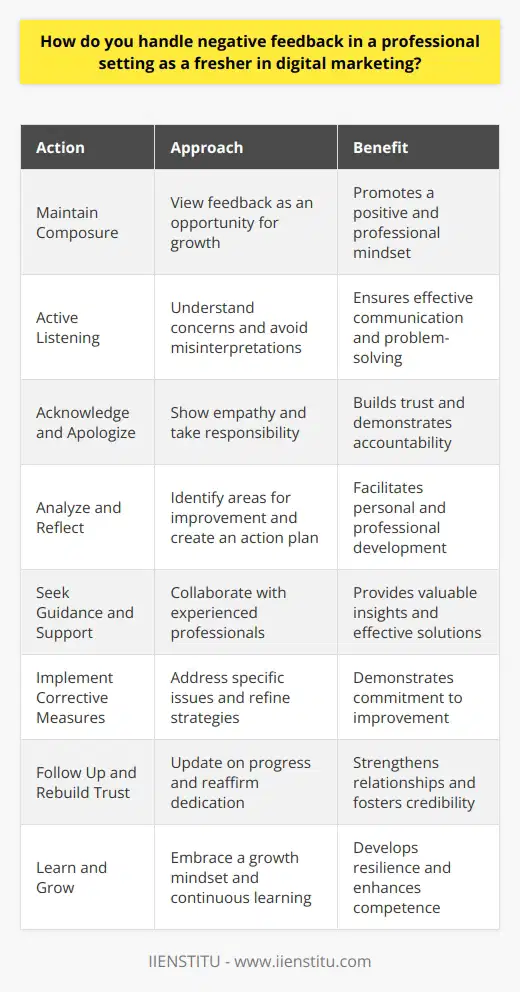
What strategies would you employ to effectively respond to constructive criticism from clients or colleagues in the digital marketing industry?
Responding to constructive criticism in the digital marketing industry requires a proactive and professional approach. Employing effective strategies can help maintain positive relationships with clients and colleagues while fostering personal and professional growth.
Listen Actively and Attentively
The first step in responding to constructive criticism is to listen actively and attentively. Pay close attention to the feedback provided, and avoid interrupting or becoming defensive. Demonstrate your engagement by maintaining eye contact and nodding occasionally to show your understanding.
Seek Clarification
If any aspect of the criticism is unclear, ask questions to gain a better understanding. Seeking clarification shows your willingness to learn and improve. It also helps prevent misinterpretations that could lead to further misunderstandings.
Acknowledge and Appreciate the Feedback
Acknowledge the person's effort in providing constructive criticism and express your appreciation for their input. Recognize that they have taken the time to offer valuable insights that can help you grow and develop in your role.
Example:
"Thank you for bringing this to my attention. I appreciate your feedback and the opportunity to improve."
Reflect on the Criticism
Take time to reflect on the constructive criticism and consider its validity. Evaluate whether the feedback aligns with your goals and the objectives of the project or task at hand. Determine if there are areas where you can make improvements based on the input provided.
Develop an Action Plan
Create an action plan to address the constructive criticism and implement necessary changes. Break down the feedback into specific, measurable, and actionable steps. Set realistic goals and timelines for each step to ensure progress and accountability.
Example:
"Based on your feedback, I plan to revise the social media strategy by conducting more thorough audience research and developing targeted content."
Follow Up and Communicate Progress
Keep the person who provided the constructive criticism informed about your progress in addressing their feedback. Share updates on the actions you have taken and the results achieved. This demonstrates your commitment to improvement and helps build trust and credibility.
Example:
"I wanted to let you know that I have implemented the changes we discussed regarding the email marketing campaign. The open rates have increased by 15% since making those adjustments."
Embrace Continuous Learning
View constructive criticism as an opportunity for growth and learning. Embrace a mindset of continuous improvement and actively seek feedback from clients and colleagues. Regularly assess your performance and identify areas where you can enhance your skills and knowledge in the digital marketing field.
By employing these strategies, you can effectively respond to constructive criticism in the digital marketing industry. Remember that feedback is a valuable tool for personal and professional development, and approaching it with a positive and proactive mindset can lead to long-term success.
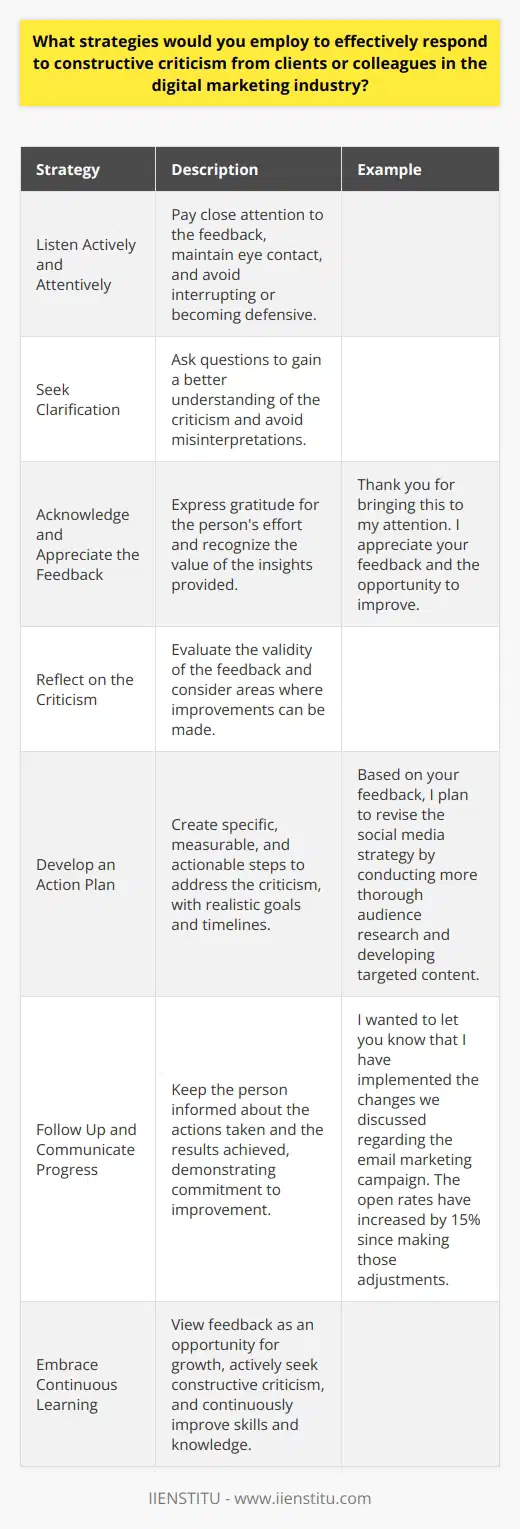
As a fresher in digital marketing, how would you approach incorporating feedback to improve your skills and performance?
As a fresher in digital marketing, incorporating feedback is crucial for improving skills and performance. The first step is to actively seek feedback from supervisors, colleagues, and clients. This feedback can provide valuable insights into areas that need improvement. It is important to listen carefully to the feedback and ask clarifying questions to ensure a full understanding of the issues raised.
Once feedback has been received, it is essential to analyze it objectively. This involves separating personal feelings from the constructive criticism provided. By maintaining an open mind and a willingness to learn, freshers can identify specific areas where they need to focus their efforts.
Developing an Action Plan
After analyzing the feedback, the next step is to develop an action plan. This plan should outline specific steps to address the identified areas of improvement. It is important to set realistic goals and timelines for each step of the plan. This will help ensure that progress is made in a structured and manageable way.
Setting SMART Goals
When setting goals, it is helpful to use the SMART framework. This means that goals should be Specific, Measurable, Achievable, Relevant, and Time-bound. For example, instead of setting a vague goal like "improve copywriting skills," a SMART goal might be "complete a copywriting course and write five practice pieces within the next month."
Seeking Additional Training and Resources
In addition to setting goals, freshers should also seek out additional training and resources to help them improve their skills. This may include attending workshops, webinars, or conferences related to digital marketing. It may also involve reading industry blogs, books, or case studies to gain new insights and perspectives.
Finding a Mentor
Another valuable resource for freshers is a mentor. A mentor is an experienced professional who can provide guidance, support, and advice as freshers navigate their careers. Freshers can seek out mentors within their own organization or through professional networks such as LinkedIn.
Implementing Changes and Monitoring Progress
As freshers implement their action plans and seek additional resources, it is important to monitor progress regularly. This involves tracking metrics related to their goals and assessing whether they are making the desired improvements. If progress is slow or goals are not being met, freshers may need to adjust their action plans or seek additional support.
Celebrating Successes
Finally, it is important for freshers to celebrate their successes along the way. Acknowledging progress and achievements can help maintain motivation and momentum. It can also help build confidence and reinforce the value of incorporating feedback into one's professional development.
Conclusion
Incorporating feedback is an ongoing process that requires a commitment to continuous learning and growth. By actively seeking feedback, analyzing it objectively, developing action plans, seeking additional resources, and monitoring progress, freshers in digital marketing can improve their skills and performance over time. With persistence and dedication, they can become valuable contributors to their organizations and successful professionals in their field.
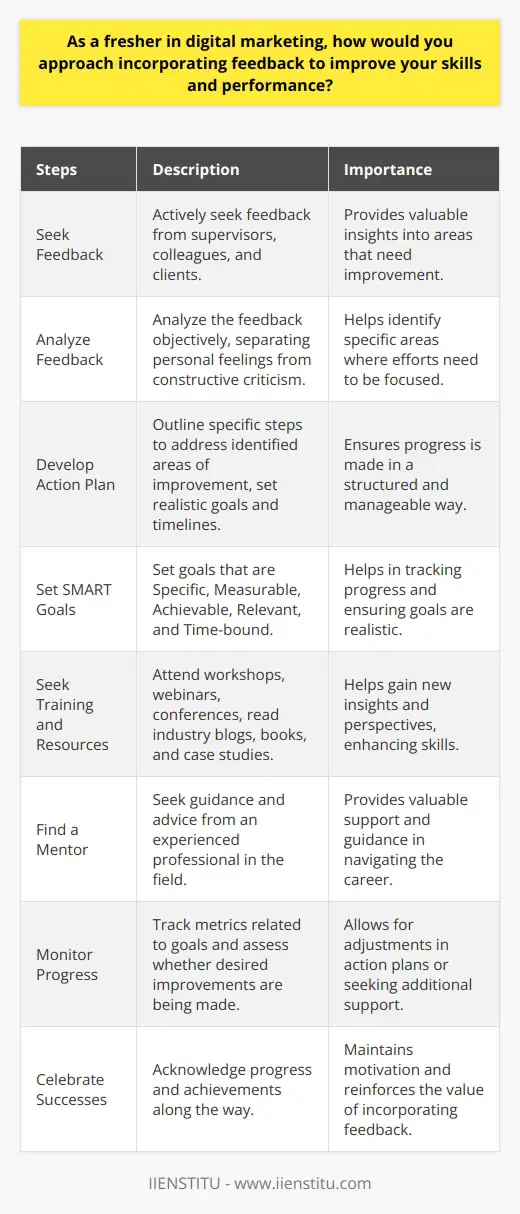
What are some common digital marketing interview questions and their appropriate answers?
Digital marketing interviews often focus on a candidate's knowledge of various online marketing strategies and their ability to apply them effectively. Some common questions that may be asked include:
1. What is your experience with search engine optimization (SEO)?
A strong answer would demonstrate an understanding of SEO best practices, such as keyword research, on-page optimization, and link building. The candidate should provide examples of how they have successfully implemented SEO strategies in previous roles.
2. How do you measure the success of a digital marketing campaign?
The candidate should discuss the importance of setting clear goals and key performance indicators (KPIs) for each campaign. They should also mention the use of analytics tools to track metrics such as website traffic, conversion rates, and return on investment (ROI).
Common KPIs include:
Click-through rate (CTR)
Engagement rate
Cost per acquisition (CPA)
Customer lifetime value (CLV)
3. What social media platforms do you have experience with, and how do you optimize content for each?
The candidate should showcase their knowledge of popular social media platforms, such as Facebook, Twitter, Instagram, and LinkedIn. They should explain how they tailor content and strategies to suit each platform's unique audience and features.
For example:
Instagram focuses on visually engaging content
Twitter is ideal for short, snappy updates and real-time engagement
LinkedIn is suited for professional content and networking
4. How do you stay up-to-date with the latest digital marketing trends and best practices?
A strong candidate will demonstrate a passion for continuous learning and staying informed about industry developments. They may mention following industry blogs, attending conferences or webinars, and participating in online communities.
5. Can you describe a successful digital marketing campaign you worked on and what made it effective?
The candidate should provide a specific example that highlights their ability to plan, execute, and optimize a digital marketing campaign. They should discuss the goals, strategies employed, and the measurable results achieved.
In summary, digital marketing interviews assess a candidate's technical knowledge, strategic thinking, and problem-solving skills. By providing clear, concise, and relevant answers backed by real-world examples, candidates can demonstrate their suitability for the role and stand out from other applicants.

How can I prepare for a digital marketing interview and answer questions effectively?
Preparing for a digital marketing interview requires a comprehensive approach that involves researching the company, reviewing your qualifications, and practicing your responses. Start by thoroughly examining the job description and identifying the key skills and experiences the employer seeks. Investigate the company's website, social media presence, and industry to gain insights into their marketing strategies and challenges. Review your own marketing experiences and accomplishments, and consider how they align with the company's needs.
Anticipate Common Interview Questions
Anticipate common digital marketing interview questions and craft thoughtful, concise responses that highlight your relevant skills and experiences. Some typical questions include:
What digital marketing channels have you used, and which ones have been most effective?
How do you measure the success of a digital marketing campaign?
What strategies have you used to increase website traffic and conversions?
How do you stay up-to-date with the latest digital marketing trends and best practices?
Use the STAR Method
When answering questions, use the STAR method (Situation, Task, Action, Result) to provide concrete examples of your accomplishments. Describe the situation or challenge you faced, the task you needed to complete, the actions you took, and the results you achieved. This approach helps you provide clear, concise, and compelling responses that demonstrate your value to the employer.
Prepare Questions for the Interviewer
Prepare thoughtful questions for the interviewer that demonstrate your interest in the company and the role. Ask about the company's marketing goals, challenges, and opportunities for growth and development. This shows that you have done your research and are genuinely interested in contributing to the company's success.
Practice, Practice, Practice
Practice your responses to common interview questions with a friend, family member, or mentor. Ask for feedback on your content, clarity, and delivery. The more you practice, the more confident and articulate you will be during the actual interview.
Be Confident and Authentic
During the interview, be confident, enthusiastic, and authentic. Smile, make eye contact, and engage with the interviewer. Show that you are passionate about digital marketing and excited about the opportunity to contribute to the company's success.
Follow Up After the Interview
After the interview, send a thank-you note or email to the interviewer within 24 hours. Reiterate your interest in the position and the company, and highlight a few key points from the interview. This shows your professionalism and enthusiasm, and can help you stand out from other candidates.
By following these strategies, you can prepare effectively for a digital marketing interview and increase your chances of landing the job. Remember to be confident, authentic, and enthusiastic, and to demonstrate your value through concrete examples of your skills and experiences.
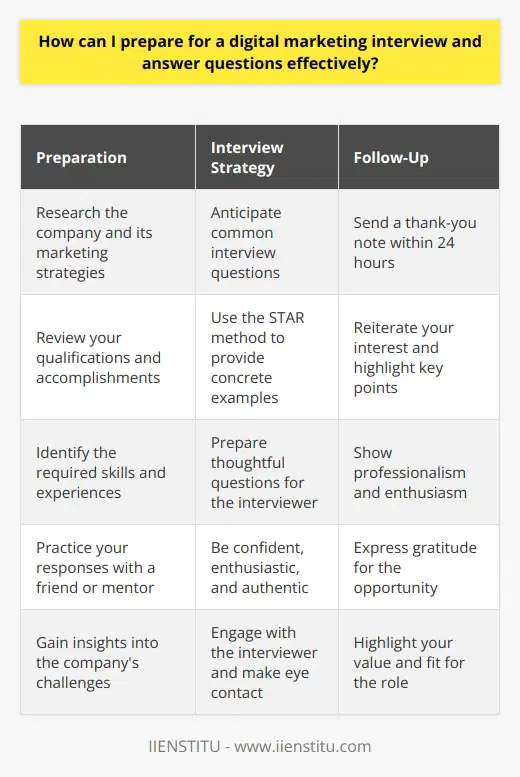
What are the most important digital marketing concepts to understand before an interview, and how can I articulate my knowledge of them when answering questions?
Before attending a digital marketing interview, it is crucial to grasp several key concepts and articulate them effectively. First, understand the importance of search engine optimization (SEO) and how it improves a website's visibility in search results. Be prepared to discuss on-page and off-page SEO techniques, such as keyword research, content optimization, and link building. Second, familiarize yourself with pay-per-click (PPC) advertising, particularly Google Ads, and how it can drive targeted traffic to a website. Explain your experience with creating ad campaigns, selecting keywords, and analyzing performance metrics like click-through rates (CTR) and conversion rates.
Social Media Marketing
Demonstrating a solid understanding of social media marketing is essential. Discuss how to develop a social media strategy, create engaging content, and measure the success of campaigns across various platforms like Facebook, Instagram, and Twitter. Highlight your ability to identify target audiences, optimize content for each platform, and analyze metrics such as reach, engagement, and conversions.
Content Marketing
Content marketing is another crucial aspect of digital marketing. Explain how to create valuable and relevant content that attracts and retains a clearly defined audience. Discuss various content formats, such as blog posts, infographics, videos, and eBooks, and how they can be used to achieve specific marketing goals. Emphasize the importance of understanding the target audience and creating content that addresses their pain points and interests.
Email Marketing
Be prepared to discuss email marketing strategies and how they can be used to nurture leads and drive conversions. Explain the process of building an email list, segmenting audiences, and creating targeted email campaigns. Highlight your experience with email marketing tools, such as Mailchimp or Constant Contact, and your ability to analyze key metrics like open rates, click-through rates, and conversion rates.
Analytics and Reporting
Demonstrating your knowledge of analytics and reporting is crucial. Discuss how to use tools like Google Analytics to track website traffic, user behavior, and conversions. Explain how to set up goals and funnels, interpret data, and create meaningful reports that inform marketing decisions. Showcase your ability to identify trends, draw insights, and make data-driven recommendations for improving digital marketing strategies.
Mobile Marketing
With the increasing use of mobile devices, understanding mobile marketing is essential. Discuss how to optimize websites and content for mobile devices, create mobile-friendly ad campaigns, and leverage mobile-specific features like geotargeting and push notifications. Explain your experience with mobile app marketing and how to measure the success of mobile campaigns using relevant metrics.
When articulating your knowledge of these digital marketing concepts during an interview, use clear and concise language. Provide specific examples from your experience to demonstrate your practical application of these concepts. Use industry-specific terms to showcase your familiarity with the field, but be sure to explain them if asked. Be honest about your level of expertise and show enthusiasm for continuing to learn and grow in the ever-evolving digital marketing landscape.
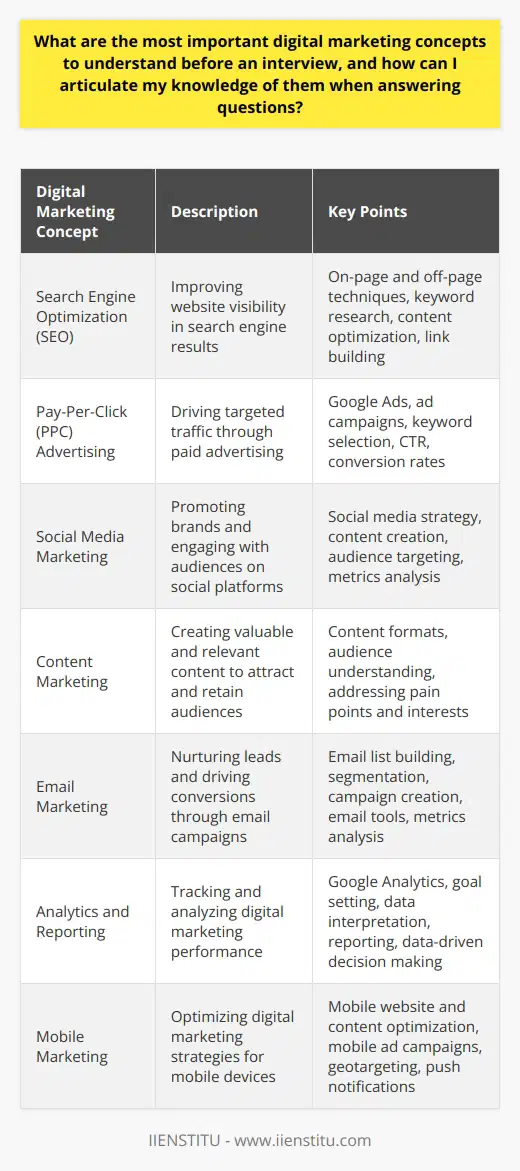
What are some common questions asked in digital marketing interviews?
Digital marketing interviews often focus on assessing a candidate's knowledge, skills, and experience in various aspects of online marketing. Interviewers typically ask questions related to digital marketing strategies, tactics, tools, and best practices. Some common questions revolve around the candidate's experience with search engine optimization (SEO), pay-per-click (PPC) advertising, social media marketing, content marketing, and email marketing.
SEO and PPC Questions
Interviewers may ask candidates to explain their understanding of SEO and how they have implemented SEO strategies in the past. They may inquire about the candidate's experience with keyword research, on-page optimization, link building, and tracking SEO performance. Additionally, questions related to PPC advertising, such as experience with Google Ads, ad copywriting, and bid management, are common.
Example SEO questions:
How do you conduct keyword research?
What are some on-page optimization techniques you have used?
How do you measure the success of an SEO campaign?
Example PPC questions:
What experience do you have with Google Ads?
How do you write effective ad copy?
How do you optimize bids and budgets in PPC campaigns?
Social Media and Content Marketing Questions
Interviewers often ask candidates about their experience with social media platforms, such as Facebook, Twitter, and Instagram. They may inquire about the candidate's strategies for growing social media followers, engaging with audiences, and measuring the success of social media campaigns. Questions related to content marketing, such as experience with creating and promoting blog posts, videos, and other types of content, are also common.
Example social media questions:
What strategies have you used to grow social media followers?
How do you engage with audiences on social media?
How do you measure the ROI of social media campaigns?
Example content marketing questions:
What types of content have you created and promoted?
How do you develop content ideas that resonate with target audiences?
How do you measure the success of content marketing efforts?
Email Marketing and Analytics Questions
Interviewers may ask candidates about their experience with email marketing, including designing email templates, writing subject lines, and segmenting email lists. They may also inquire about the candidate's knowledge of email marketing best practices and their experience with email marketing tools. Additionally, questions related to web analytics, such as experience with Google Analytics, interpreting data, and making data-driven decisions, are common.
Example email marketing questions:
What email marketing tools have you used?
How do you segment email lists for targeted campaigns?
What strategies do you use to improve email open and click-through rates?
Example analytics questions:
What experience do you have with Google Analytics?
How do you interpret website traffic data?
How do you use data to make informed marketing decisions?
By preparing for these common digital marketing interview questions, candidates can demonstrate their knowledge and experience to potential employers. It's essential to provide specific examples and results from past campaigns to showcase expertise and problem-solving skills in digital marketing.

How can I prepare for a digital marketing interview?
To prepare for a digital marketing interview, you should focus on several key areas. First, research the company thoroughly. Understand their products, services, target audience, and competitors. This knowledge will demonstrate your interest and help you provide relevant answers.
Next, review common digital marketing concepts and techniques. These include SEO, PPC, social media marketing, content marketing, and email marketing. Be prepared to discuss how you have used these strategies in your previous roles and the results you achieved.
Brush Up on Your Skills
Brush up on your analytical skills. Digital marketing relies heavily on data analysis to measure campaign effectiveness and optimize strategies. Familiarize yourself with tools like Google Analytics and be ready to discuss how you interpret and use data to make informed decisions.
Practice discussing your experience with various digital marketing tools and platforms. These may include social media management tools, email marketing software, and content management systems. Demonstrate your proficiency and adaptability in using these tools to achieve marketing goals.
Prepare Examples and Case Studies
Prepare specific examples and case studies from your previous work. Be ready to discuss the challenges you faced, the strategies you implemented, and the results you achieved. Use quantifiable data to support your examples whenever possible.
Anticipate common interview questions and practice your responses. These may include questions about your experience, your approach to problem-solving, and how you stay updated with industry trends. Practice concise and articulate answers that highlight your skills and achievements.
Showcase Your Portfolio
Create a portfolio showcasing your best digital marketing work. This can include campaigns you have managed, content you have created, or websites you have optimized. Be prepared to discuss the strategies behind each piece and the impact they had on the business.
Develop a Strong Online Presence
Ensure your online presence reflects your digital marketing expertise. Update your LinkedIn profile, personal website, and any other relevant online platforms. Showcase your skills, experience, and accomplishments in a clear and compelling manner.
Finally, stay updated on the latest digital marketing trends and news. Read industry blogs, follow thought leaders on social media, and attend webinars or conferences when possible. Demonstrating your knowledge of current trends will show your passion for the field and your commitment to continuous learning.
By following these steps, you can prepare yourself for a successful digital marketing interview. Remember to showcase your skills, experience, and enthusiasm for the field, and you will be well on your way to landing your desired role.

Where can I find a comprehensive list of digital marketing interview questions and answers in PDF format?
Finding a comprehensive list of digital marketing interview questions and answers in PDF format is possible through various online resources. Websites such as LinkedIn, Glassdoor, and Indeed often have user-generated content that includes interview questions for specific roles, including digital marketing positions. Additionally, many digital marketing blogs and websites offer free downloadable PDFs that compile common interview questions and suggested answers.
Searching for Digital Marketing Interview Questions on Job Search Websites
Job search websites like LinkedIn, Glassdoor, and Indeed are excellent sources for finding digital marketing interview questions. These platforms allow users to share their interview experiences, including the questions they were asked during the process. By searching for "digital marketing interview questions" on these websites, you can access a wealth of user-generated content that provides insight into the types of questions you may encounter during a digital marketing interview.
Leveraging Digital Marketing Blogs and Websites
Many digital marketing blogs and websites offer free resources, including PDF downloads that contain comprehensive lists of interview questions and answers. These resources are often created by experienced digital marketers or recruiting professionals who have a deep understanding of the industry and the hiring process. By searching for "digital marketing interview questions PDF" on search engines like Google, you can find a variety of websites that offer these valuable resources.
Evaluating the Quality and Relevance of PDF Resources
When searching for digital marketing interview questions and answers in PDF format, it's essential to evaluate the quality and relevance of the resources you find. Look for PDFs that are created by reputable sources, such as well-known digital marketing blogs or industry experts. Additionally, ensure that the questions and answers provided are up-to-date and relevant to the current digital marketing landscape, as the industry is constantly evolving.
Customizing Your Interview Preparation
While comprehensive lists of digital marketing interview questions and answers in PDF format can be incredibly helpful, it's important to customize your interview preparation based on the specific role and company you are interviewing for. Research the company's digital marketing strategies, target audience, and competitor landscape to tailor your answers to their unique needs and goals. By combining the insights gained from PDF resources with your own research and experiences, you'll be well-prepared to ace your digital marketing interview.

What are your greatest strengths and weaknesses?
Self-awareness is crucial for personal growth and development. Recognizing one's strengths and weaknesses allows for targeted improvement and optimization of skills. My greatest strengths lie in my analytical thinking, attention to detail, and strong work ethic. I excel at breaking down complex problems into manageable components and finding effective solutions. Additionally, I am highly organized and meticulous in my approach to tasks, ensuring high-quality results. However, I acknowledge that my weaknesses include a tendency to be overly self-critical and hesitant to take risks. I sometimes struggle with delegating tasks and trusting others to meet my high standards.
Leveraging Strengths for Success
To maximize my potential, I actively seek opportunities to utilize my strengths. In academic and professional settings, I gravitate towards roles that require problem-solving and critical thinking. I thrive when given the chance to analyze data, identify patterns, and develop innovative strategies. By leveraging my attention to detail, I produce thorough and accurate work that sets me apart from others. Furthermore, my strong work ethic drives me to consistently deliver results, even under challenging circumstances. I am committed to continuous learning and improvement, always striving to expand my knowledge and skills.
Strategies for Overcoming Weaknesses
Recognizing my weaknesses is the first step in overcoming them. To combat my self-critical tendencies, I practice self-compassion and celebrate my successes, no matter how small. I actively seek feedback from others to gain a more balanced perspective on my abilities. When it comes to risk-taking, I push myself out of my comfort zone by setting achievable goals and gradually increasing the level of challenge. I also work on building trust with colleagues and delegating tasks when appropriate, understanding that collaboration can lead to greater success.
The Role of Continuous Improvement
Personal growth is an ongoing journey, and I am committed to continuous improvement. I regularly reflect on my strengths and weaknesses, setting specific goals for development. I seek out mentors and engage in professional development opportunities to acquire new skills and knowledge. By embracing a growth mindset, I view challenges as opportunities for learning and improvement rather than obstacles to success. I understand that setbacks are a natural part of the process and use them as fuel for future growth.
Balancing Strengths and Weaknesses
Ultimately, the key to success lies in finding a balance between leveraging strengths and addressing weaknesses. By focusing on areas where I excel, I can make significant contributions and create value. At the same time, by acknowledging and working on my weaknesses, I become a more well-rounded and adaptable individual. Through self-awareness, targeted effort, and a commitment to continuous improvement, I strive to optimize my potential and achieve my goals.
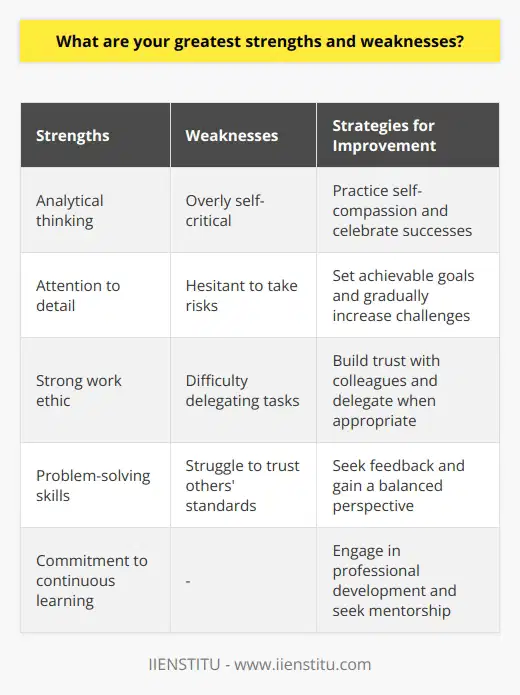
How do you stay up-to-date with the latest digital marketing trends and strategies?
Staying up-to-date with the latest digital marketing trends and strategies is crucial for marketers to remain competitive. One effective approach is to regularly read industry blogs and publications, such as Search Engine Journal and Social Media Examiner. These resources provide valuable insights into emerging trends, best practices, and case studies from experts in the field. Attending digital marketing conferences and webinars is another excellent way to learn from thought leaders and network with peers. These events often showcase cutting-edge technologies and strategies that can be applied to improve marketing campaigns. Additionally, following influential marketers and brands on social media platforms like Twitter and LinkedIn can provide a steady stream of relevant content and discussions. Engaging with these communities can also lead to valuable connections and collaborations. Another approach is to experiment with new marketing tools and platforms, such as AI-powered chatbots or interactive video ads. By testing these innovations firsthand, marketers can gain practical experience and identify opportunities to integrate them into their strategies. Finally, regularly analyzing data from marketing campaigns can reveal trends and insights that inform future decisions. By monitoring metrics such as engagement rates, conversion rates, and customer acquisition costs, marketers can continuously optimize their strategies based on real-world performance. Staying up-to-date with digital marketing trends requires a proactive and multifaceted approach, but the benefits are well worth the effort.
Read Industry Blogs and Publications
Regularly reading industry blogs and publications is a great way to stay informed about the latest digital marketing trends. Websites like Search Engine Journal, Social Media Examiner, and Marketing Land provide valuable insights from experts in the field. These resources often feature case studies, best practices, and analyses of emerging technologies and strategies. By subscribing to their newsletters or RSS feeds, marketers can ensure they never miss an important update.
Attend Digital Marketing Conferences and Webinars
Digital marketing conferences and webinars offer excellent opportunities to learn from thought leaders and network with peers. These events often showcase cutting-edge technologies and strategies that can be applied to improve marketing campaigns. Many conferences, such as Content Marketing World and MozCon, also provide valuable workshops and hands-on training sessions. Webinars are a convenient alternative for marketers who cannot attend in-person events, as they can be accessed from anywhere with an internet connection.
Follow Influential Marketers and Brands on Social Media
Following influential marketers and brands on social media platforms like Twitter and LinkedIn can provide a steady stream of relevant content. These thought leaders often share their insights, opinions, and experiences related to digital marketing trends and strategies. Engaging with their posts by commenting or sharing can also lead to valuable connections and collaborations. Additionally, joining social media groups and communities focused on digital marketing can provide access to exclusive content and discussions.
Experiment with New Marketing Tools and Platforms
Experimenting with new marketing tools and platforms is another effective way to stay up-to-date with digital marketing trends. AI-powered chatbots, interactive video ads, and voice search optimization are just a few examples of innovations that marketers can test firsthand. By gaining practical experience with these technologies, marketers can identify opportunities to integrate them into their strategies and stay ahead of the curve.
Analyze Data from Marketing Campaigns
Regularly analyzing data from marketing campaigns can reveal valuable trends and insights that inform future decisions. By monitoring metrics such as engagement rates, conversion rates, and customer acquisition costs, marketers can identify areas for improvement and optimize their strategies accordingly. Tools like Google Analytics, SEMrush, and Hootsuite provide robust data analysis capabilities that can help marketers stay up-to-date with the latest trends and benchmarks in their industries.
Continuously Adapt and Refine Strategies
Staying up-to-date with digital marketing trends requires a continuous process of learning, experimentation, and refinement. As new technologies and strategies emerge, marketers must be willing to adapt their approaches and embrace change. By staying curious, proactive, and data-driven, marketers can successfully navigate the ever-evolving landscape of digital marketing and achieve their goals.
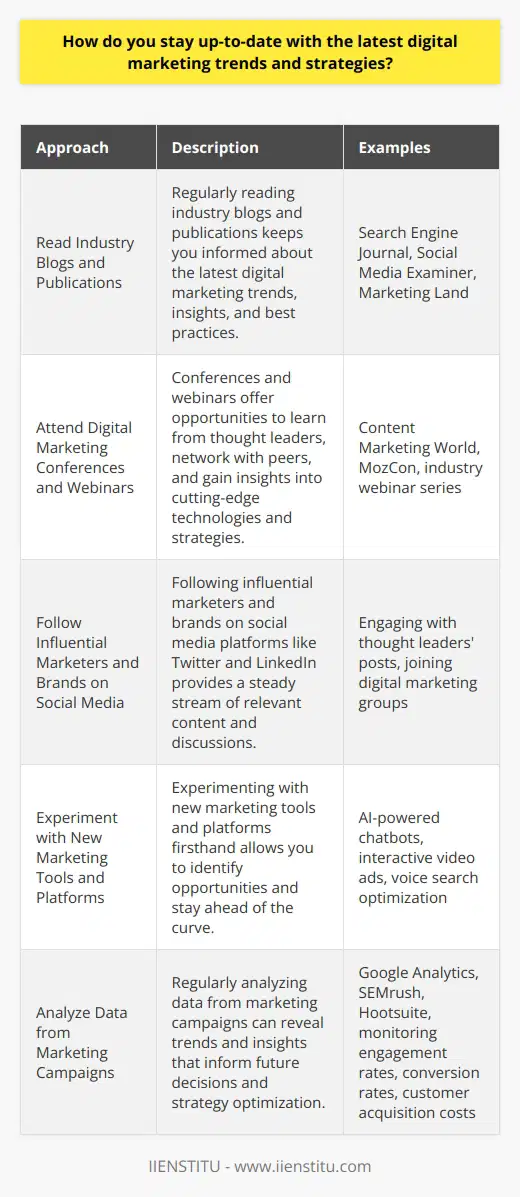
Can you describe a successful digital marketing campaign you have worked on and what made it effective?
One successful digital marketing campaign I worked on involved promoting a new line of eco-friendly clothing. The campaign's effectiveness stemmed from several key factors, including a well-defined target audience, compelling content, and a multi-channel approach.
Defining the Target Audience
We began by thoroughly researching our target audience, which consisted of environmentally-conscious millennials. This allowed us to tailor our messaging and visuals to resonate with their values and preferences.
Creating Personas
To better understand our audience, we created detailed buyer personas. These personas helped guide our content creation and distribution strategies.
Developing Compelling Content
Our content strategy focused on creating engaging and informative pieces that showcased the benefits of eco-friendly clothing. We utilized a variety of formats, including blog posts, infographics, and videos.
Blog Posts
We published a series of blog posts that discussed the environmental impact of fast fashion and highlighted our products' sustainable features. These posts aimed to educate and inspire readers to make more eco-conscious choices.
Infographics
We created visually appealing infographics that illustrated the lifecycle of our eco-friendly clothing. These infographics were shared widely on social media and helped increase brand awareness.
Videos
We produced short video interviews with influencers and customers who shared their experiences with our products. These videos provided social proof and helped build trust with our target audience.
Implementing a Multi-Channel Approach
To maximize our reach, we implemented a multi-channel approach that included social media, email marketing, and influencer partnerships.
Social Media
We actively engaged with our target audience on Instagram, Facebook, and Twitter. We shared our content, ran targeted ads, and encouraged user-generated content through hashtag campaigns.
Email Marketing
We segmented our email list based on subscriber preferences and sent personalized newsletters featuring our latest content and product releases. This helped nurture leads and drive conversions.
Influencer Partnerships
We partnered with eco-conscious influencers to create sponsored content and product reviews. These partnerships helped expand our reach and lend credibility to our brand.
Measuring Success
Throughout the campaign, we closely monitored key performance indicators such as website traffic, engagement rates, and conversions. By continuously analyzing and optimizing our strategies, we were able to achieve significant growth in brand awareness and sales.
Website Traffic
Our campaign resulted in a 150% increase in website traffic, with a significant portion coming from new visitors.
Engagement Rates
Our content consistently achieved high engagement rates, with an average of 1,000 shares and 5,000 likes per post.
Conversions
The campaign generated a 30% increase in product sales, with a 10% conversion rate from website visitors.
In conclusion, the success of this digital marketing campaign can be attributed to a clear understanding of our target audience, the creation of compelling content, and the implementation of a multi-channel approach. By continuously monitoring and optimizing our strategies, we were able to achieve significant growth in brand awareness and sales.

What are the key components of a successful digital marketing strategy?
A successful digital marketing strategy consists of several key components that work together to achieve business goals. These components include a well-defined target audience, clear objectives, and a comprehensive plan for reaching and engaging customers. A strong digital marketing strategy also incorporates a mix of tactics, such as search engine optimization (SEO), content marketing, social media marketing, email marketing, and paid advertising.
Defining Your Target Audience
To create a successful digital marketing strategy, you must first identify your target audience. This involves researching and understanding the demographics, interests, and behaviors of your ideal customers. By clearly defining your target audience, you can tailor your marketing messages and tactics to effectively reach and resonate with them.
Conducting Market Research
Thorough market research is essential for gaining insights into your target audience. Use tools like surveys, interviews, and analytics to gather data on your customers' preferences, pain points, and online behaviors. This information will help you create buyer personas, which are detailed representations of your ideal customers.
Setting Clear Objectives
A successful digital marketing strategy must have clear, measurable objectives. These objectives should align with your overall business goals and be specific, achievable, and time-bound. Examples of digital marketing objectives include increasing website traffic, generating leads, improving conversion rates, and building brand awareness.
Defining Key Performance Indicators (KPIs)
To measure the success of your digital marketing efforts, you need to establish key performance indicators (KPIs). KPIs are metrics that help you track progress towards your objectives. Some common KPIs in digital marketing include website traffic, engagement rates, conversion rates, and return on investment (ROI).
Developing a Comprehensive Tactical Plan
A successful digital marketing strategy requires a comprehensive tactical plan that outlines the specific actions you will take to achieve your objectives. This plan should include a mix of digital marketing tactics tailored to your target audience and goals.
Search Engine Optimization (SEO)
SEO is the practice of optimizing your website and content to rank higher in search engine results pages (SERPs). By improving your search engine rankings, you can increase organic traffic to your website and reach more potential customers.
Content Marketing
Content marketing involves creating and distributing valuable, relevant, and consistent content to attract and retain a clearly defined audience. By providing informative and engaging content, you can build trust with your target audience and establish your brand as a thought leader in your industry.
Social Media Marketing
Social media marketing involves promoting your brand and engaging with your target audience on social media platforms like Facebook, Twitter, and Instagram. By building a strong social media presence, you can increase brand awareness, drive traffic to your website, and foster customer loyalty.
Email Marketing
Email marketing involves sending targeted, personalized emails to your subscribers to promote your products or services, share valuable content, and build relationships with your customers. By segmenting your email list and delivering relevant content, you can improve engagement and conversion rates.
Paid Advertising
Paid advertising, also known as pay-per-click (PPC) advertising, involves placing ads on search engines, social media platforms, and other websites to reach your target audience. By targeting your ads based on keywords, demographics, and interests, you can drive qualified traffic to your website and achieve a higher ROI.
Monitoring, Analyzing, and Optimizing
A successful digital marketing strategy requires continuous monitoring, analysis, and optimization. By tracking your KPIs and analyzing your marketing campaigns' performance, you can identify areas for improvement and make data-driven decisions to optimize your strategy.
Regularly review your tactics, assess their effectiveness, and make necessary adjustments to ensure that your digital marketing strategy remains aligned with your business goals and target audience. Stay up-to-date with the latest digital marketing trends and best practices to stay ahead of the competition and maximize your results.
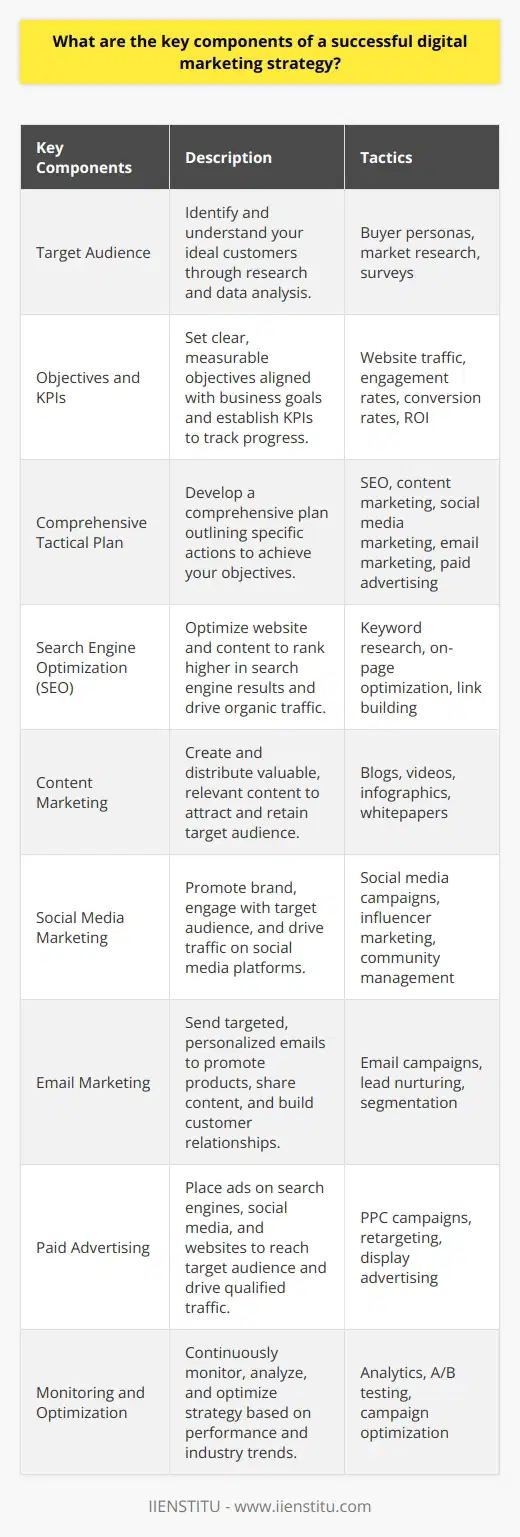
What metrics should be used to measure the effectiveness of digital marketing efforts?
Measuring the effectiveness of digital marketing efforts is crucial for businesses to optimize their strategies and allocate resources efficiently. Several key metrics can be used to assess the performance of digital marketing campaigns. Firstly, website traffic is a fundamental metric that indicates the number of visitors attracted to a business's online presence. By analyzing website traffic, marketers can evaluate the reach and visibility of their campaigns across various channels.
Secondly, engagement metrics, such as bounce rate, time on site, and pages per session, provide insights into how well the website content resonates with the target audience. A high bounce rate suggests that visitors are not finding the information they seek, while a longer time on site and more pages per session indicate a more engaged audience.
Conversion Rates
Thirdly, conversion rates are essential for measuring the success of digital marketing efforts in driving desired actions, such as sales, sign-ups, or lead generation. By tracking conversion rates, businesses can determine the effectiveness of their calls-to-action and optimize their campaigns accordingly.
Return on Investment (ROI)
Fourthly, Return on Investment (ROI) is a critical metric for evaluating the financial impact of digital marketing campaigns. By comparing the revenue generated from a campaign to its associated costs, businesses can determine the profitability and efficiency of their marketing efforts.
Customer Lifetime Value (CLV)
Additionally, Customer Lifetime Value (CLV) is a valuable metric for assessing the long-term impact of digital marketing on customer relationships. By calculating the projected revenue a customer will generate throughout their relationship with the business, marketers can make informed decisions about customer acquisition and retention strategies.
Social Media Metrics
Furthermore, social media metrics, such as followers, likes, shares, and comments, provide insights into the reach and engagement of a business's social media presence. By monitoring these metrics, marketers can identify the most effective social media channels and adjust their content strategies accordingly.
In conclusion, a comprehensive set of metrics, including website traffic, engagement, conversion rates, ROI, CLV, and social media metrics, should be used to measure the effectiveness of digital marketing efforts. By regularly monitoring and analyzing these metrics, businesses can make data-driven decisions to optimize their digital marketing strategies and achieve their goals.
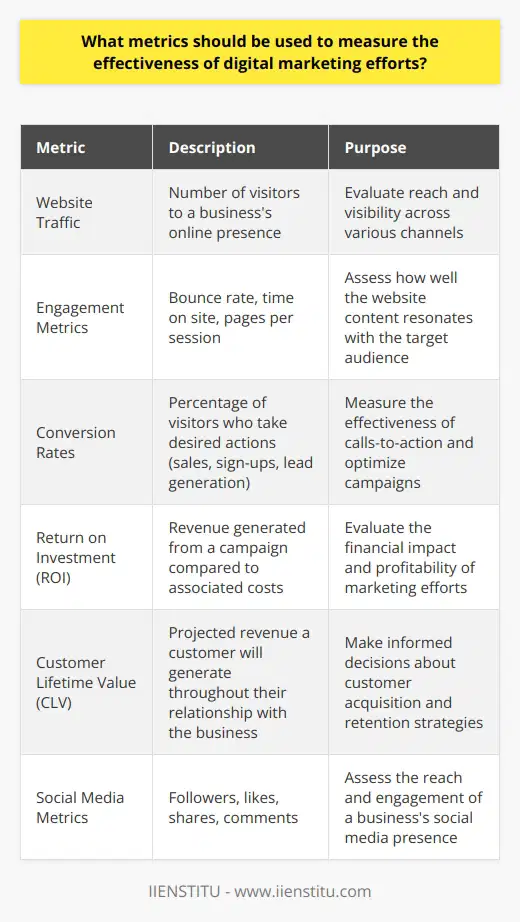
Why do you want to pursue a career in digital marketing?
Digital marketing has emerged as a dynamic and rapidly growing field that offers numerous opportunities for creative professionals. The ever-evolving digital landscape presents a chance to combine analytical thinking with innovative strategies to reach target audiences effectively. Pursuing a career in digital marketing allows individuals to harness the power of technology and data-driven insights to create compelling campaigns.
The Allure of Digital Marketing
The world of digital marketing is alluring due to its fast-paced nature and the ability to make a tangible impact. In today's digital age, businesses heavily rely on online platforms to engage with their customers and promote their products or services. Digital marketers play a crucial role in developing and executing strategies that drive brand awareness, generate leads, and ultimately boost revenue.
Creativity and Innovation
One of the most appealing aspects of digital marketing is the opportunity to exercise creativity and think outside the box. From crafting engaging social media posts to designing eye-catching web pages, digital marketers have the freedom to experiment with various formats and channels. The digital realm encourages innovation, allowing professionals to constantly explore new ways to capture attention and deliver memorable experiences to audiences.
Data-Driven Decision Making
Digital marketing heavily relies on data analytics to inform strategic decisions and optimize campaign performance. The ability to track, measure, and analyze various metrics provides valuable insights into consumer behavior and preferences. By leveraging data, digital marketers can identify trends, refine targeting strategies, and allocate resources effectively to maximize return on investment (ROI).
Diverse Range of Specializations
Another compelling reason to pursue a career in digital marketing is the diverse range of specializations available within the field. From search engine optimization (SEO) and pay-per-click (PPC) advertising to content marketing and social media management, individuals can choose to focus on areas that align with their interests and strengths. This diversity allows professionals to continuously learn and expand their skill set, ensuring a dynamic and fulfilling career path.
Collaboration and Networking
Digital marketing often involves collaborating with cross-functional teams, including designers, developers, and content creators, to deliver cohesive campaigns. This collaborative nature fosters a stimulating work environment where ideas are shared, and skills are enhanced through teamwork. Additionally, the digital marketing community is known for its strong networking opportunities, enabling professionals to connect with industry experts, attend conferences, and participate in online forums to stay updated with the latest trends and best practices.
Impact and Growth Potential
Ultimately, pursuing a career in digital marketing offers the chance to make a significant impact on businesses and society as a whole. By creating compelling content, driving engagement, and influencing consumer behavior, digital marketers have the power to shape brand perceptions and contribute to the success of organizations. Moreover, the field of digital marketing is continually evolving, presenting endless opportunities for growth, learning, and advancement.
In conclusion, a career in digital marketing is an exciting and rewarding path for those who thrive in a dynamic, creative, and data-driven environment. The ability to combine analytical thinking with innovative strategies, the diverse range of specializations, and the potential for significant impact make digital marketing an attractive choice for professionals seeking a challenging and fulfilling career.
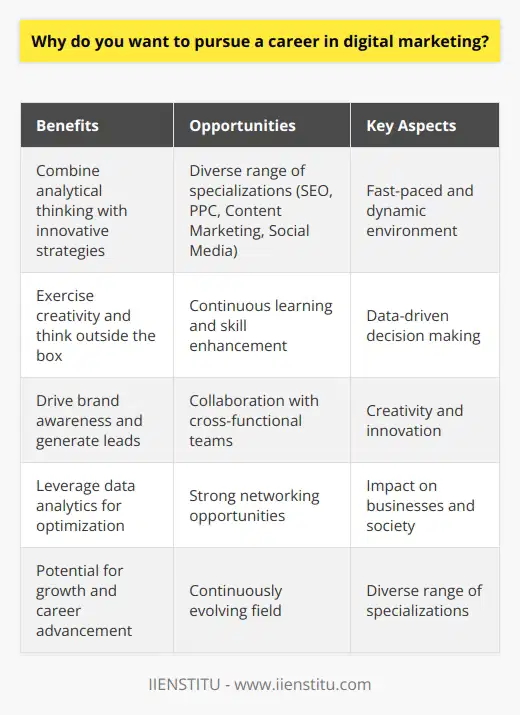
What aspects of digital marketing interest you the most, and why?
Digital marketing encompasses a wide range of strategies and tactics that fascinate me for several reasons. Firstly, the ability to reach a vast audience through various digital channels is incredibly powerful. By leveraging social media platforms, search engine optimization, and email marketing, businesses can connect with their target market on a global scale. This unprecedented reach allows for greater brand exposure and the potential to drive significant traffic to a company's website.
Secondly, the data-driven nature of digital marketing is highly appealing. With the help of analytics tools, marketers can track and measure the effectiveness of their campaigns in real-time. This data provides valuable insights into consumer behavior, preferences, and engagement levels. By analyzing this information, marketers can make informed decisions to optimize their strategies and allocate resources more efficiently. The ability to continuously refine and improve marketing efforts based on data is a game-changer in the industry.
The Power of Personalization
Another aspect of digital marketing that intrigues me is the opportunity for personalization. With the abundance of data available, marketers can create highly targeted and personalized campaigns. By understanding the demographics, interests, and behavior of their audience, businesses can deliver relevant content and offers that resonate with individual consumers. This level of personalization enhances the customer experience, builds stronger relationships, and increases the likelihood of conversions.
The Role of Content Marketing
Content marketing is a crucial component of digital marketing that I find particularly interesting. In today's digital landscape, consumers are inundated with information and advertisements. Creating valuable, informative, and engaging content helps businesses stand out from the noise and establish themselves as industry thought leaders. By providing helpful resources, such as blog posts, videos, and infographics, companies can attract and retain a loyal audience. Content marketing allows businesses to nurture relationships with their customers and guide them through the buyer's journey.
The Importance of Mobile Optimization
With the increasing prevalence of mobile devices, mobile optimization has become a critical aspect of digital marketing. Ensuring that websites and campaigns are mobile-friendly is essential for reaching and engaging with consumers on the go. Mobile optimization involves creating responsive designs, fast loading times, and intuitive navigation to provide a seamless user experience across devices. As more people rely on their smartphones for online activities, businesses that prioritize mobile optimization will have a competitive edge.
The Future of Digital Marketing
Looking ahead, the future of digital marketing is filled with exciting possibilities. The integration of artificial intelligence and machine learning will revolutionize the way businesses interact with customers. Chatbots and virtual assistants will become more sophisticated, providing personalized and instant support to users. Voice search optimization will gain prominence as more consumers use voice assistants to find information online. Additionally, the rise of augmented reality and virtual reality will create new opportunities for immersive and interactive marketing experiences.
In conclusion, the dynamic and ever-evolving nature of digital marketing makes it a fascinating field to explore. From the vast reach and data-driven insights to the power of personalization and the importance of mobile optimization, digital marketing offers endless opportunities for businesses to connect with their audience and achieve their goals. As technology continues to advance, staying up-to-date with the latest trends and best practices in digital marketing will be crucial for success in the digital age.
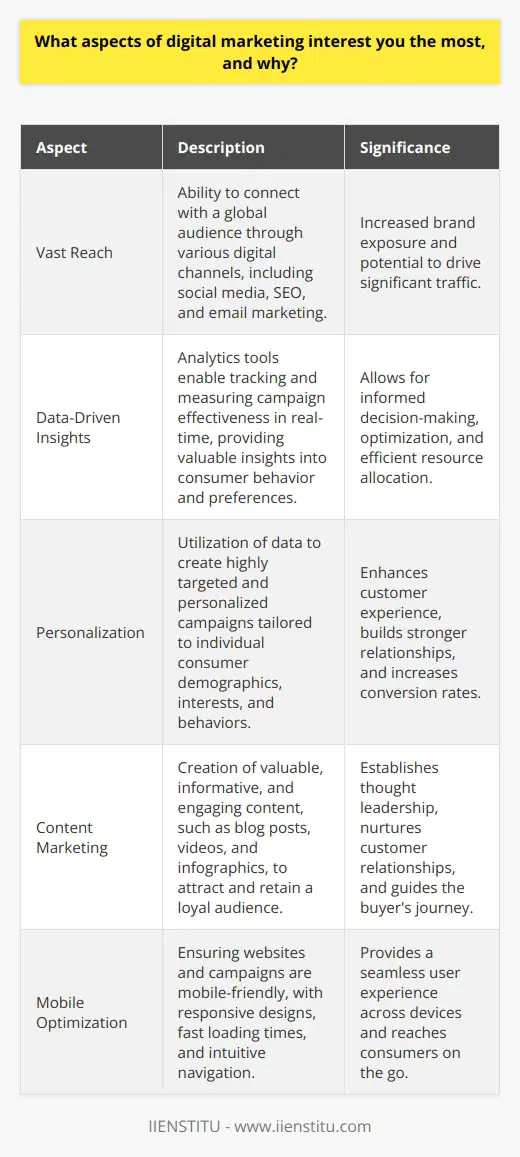
How do you think your skills and experiences align with the requirements of a digital marketing role?
My skills and experiences align well with the requirements of a digital marketing role. I have a strong foundation in marketing principles and have actively pursued opportunities to enhance my digital marketing expertise. Throughout my academic journey, I have completed courses in social media marketing, search engine optimization (SEO), and content creation, equipping me with the necessary knowledge to excel in this field.
Practical Experience in Digital Marketing
I have gained practical experience in digital marketing through internships and personal projects. During my internship at XYZ Company, I assisted in developing and executing digital marketing campaigns across various social media platforms. This hands-on experience allowed me to apply my theoretical knowledge and develop a keen understanding of audience engagement and analytics.
Content Creation and Copywriting Skills
One of my strengths is content creation and copywriting. I have a passion for crafting compelling and engaging content that resonates with target audiences. I have honed my skills in writing blog posts, social media captions, and email newsletters, always keeping in mind the importance of SEO and user experience. I believe my ability to create valuable and persuasive content will be an asset in a digital marketing role.
Data Analysis and Performance Tracking
I am well-versed in using analytics tools such as Google Analytics and social media insights to track and analyze the performance of digital marketing campaigns. I understand the significance of data-driven decision-making in optimizing marketing strategies. By leveraging data insights, I can identify areas for improvement, make informed decisions, and continuously refine campaigns to achieve better results.
Adaptability and Continuous Learning
The digital marketing landscape is constantly evolving, and I recognize the importance of staying updated with the latest trends and best practices. I am a quick learner and actively seek opportunities to expand my knowledge and skills. I regularly attend webinars, read industry blogs, and participate in online courses to stay ahead of the curve. My adaptability and willingness to learn will enable me to thrive in a dynamic digital marketing environment.
Collaboration and Communication Skills
Effective collaboration and communication are crucial in any marketing role. I have demonstrated strong teamwork abilities through group projects and collaborations. I am able to communicate ideas clearly, listen actively to feedback, and work cohesively with cross-functional teams. I believe my interpersonal skills will contribute to building positive relationships with colleagues, clients, and stakeholders.
Passion for Digital Marketing
Above all, I have a genuine passion for digital marketing. I am excited by the potential to connect with audiences, build brand awareness, and drive meaningful results. I am eager to apply my skills and knowledge to contribute to the success of a digital marketing team. I am confident that my enthusiasm, combined with my skills and experiences, makes me a strong candidate for a digital marketing role.
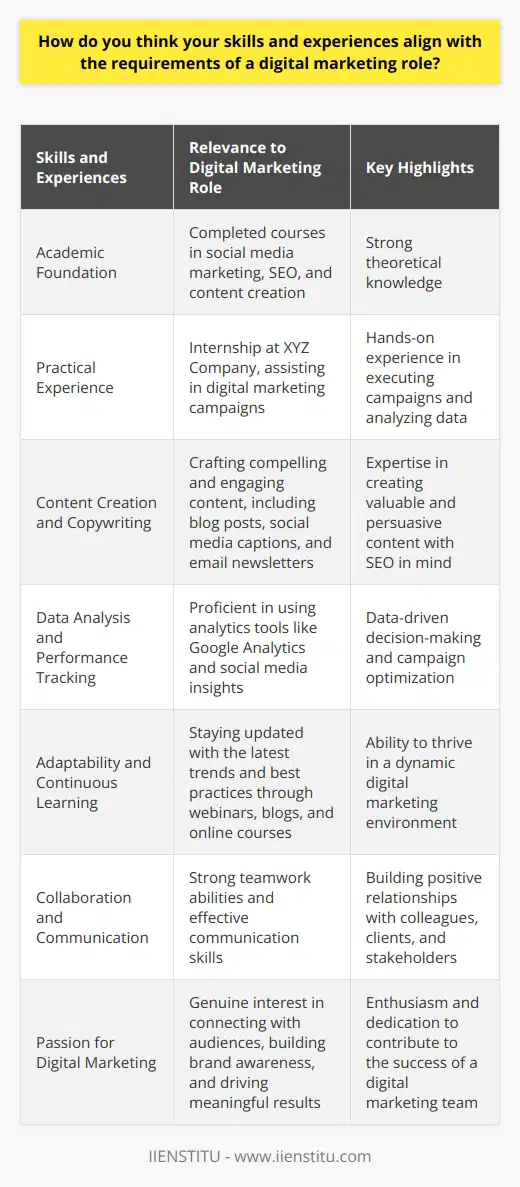
What are the key components of a successful digital marketing strategy?
A successful digital marketing strategy consists of several crucial components that work together to achieve business objectives. These components include a well-defined target audience, clear goals and objectives, and a comprehensive plan that outlines the tactics and channels to be used. A strong brand identity is also essential, as it helps to differentiate the business from competitors and build trust with potential customers.
Identifying Your Target Audience
To create a successful digital marketing strategy, you must first identify your target audience. This involves researching and understanding the demographics, interests, and behaviors of your ideal customer. Once you have a clear picture of your target audience, you can tailor your messaging and tactics to resonate with them effectively.
Setting Clear Goals and Objectives
A digital marketing strategy should have clear, measurable goals and objectives. These goals should align with your overall business objectives and be specific, achievable, and time-bound. Examples of digital marketing goals include increasing website traffic, generating leads, or improving conversions.
Developing a Comprehensive Plan
A comprehensive digital marketing plan outlines the tactics and channels you will use to reach your target audience and achieve your goals. This plan should include a mix of tactics, such as content marketing, social media marketing, email marketing, and paid advertising. It should also detail the resources and budget required to execute the plan effectively.
Building a Strong Brand Identity
A strong brand identity is crucial for a successful digital marketing strategy. Your brand should have a clear mission, values, and personality that resonate with your target audience. Consistency in messaging, visual elements, and tone across all channels is key to building a recognizable and trustworthy brand.
Analyzing and Optimizing Performance
To ensure the success of your digital marketing strategy, you must continuously analyze and optimize your performance. This involves tracking key metrics, such as website traffic, engagement rates, and conversion rates, and using this data to make informed decisions about your tactics and channels. Regular testing and experimentation can help you identify areas for improvement and optimize your strategy for better results.
Staying Up-to-Date with Industry Trends
The digital marketing landscape is constantly evolving, with new technologies, platforms, and consumer behaviors emerging regularly. To stay competitive, it's essential to stay up-to-date with industry trends and adapt your strategy accordingly. This may involve incorporating new channels or tactics, such as influencer marketing or interactive content, to keep your strategy fresh and relevant.
Conclusion
A successful digital marketing strategy requires careful planning, execution, and optimization. By identifying your target audience, setting clear goals, developing a comprehensive plan, building a strong brand identity, and continuously analyzing and optimizing your performance, you can create a digital marketing strategy that drives results and achieves your business objectives.

How can a business effectively measure the ROI of its digital marketing efforts?
Measuring the return on investment (ROI) of digital marketing efforts is crucial for businesses to optimize their strategies and allocate resources effectively. To accurately assess the ROI, companies should establish clear goals and key performance indicators (KPIs) aligned with their overall business objectives. These KPIs may include website traffic, lead generation, conversion rates, and revenue attribution.
Tracking and Analytics
Implementing comprehensive tracking and analytics tools is essential for gathering data on customer interactions and behavior across various digital channels. Google Analytics, for example, provides valuable insights into website performance, user demographics, and acquisition sources. By setting up conversion tracking, businesses can monitor the effectiveness of their campaigns in driving desired actions, such as purchases or form submissions.
Attribution Modeling
Attribution modeling helps businesses understand the contribution of each touchpoint in the customer journey. Using attribution models, such as first-touch, last-touch, or multi-touch, companies can assign credit to different marketing channels and campaigns. This enables them to identify the most effective channels and optimize their marketing mix accordingly.
Customer Lifetime Value (CLV)
Calculating the customer lifetime value (CLV) is another important aspect of measuring digital marketing ROI. CLV represents the total revenue a customer is expected to generate throughout their relationship with the business. By analyzing customer data, purchase history, and engagement patterns, companies can estimate the long-term value of acquiring and retaining customers through digital marketing efforts.
A/B Testing and Optimization
Conducting A/B tests and continuously optimizing digital marketing campaigns is crucial for improving ROI. By testing different versions of ad creatives, landing pages, or email subject lines, businesses can identify the most effective elements that drive engagement and conversions. Regular optimization ensures that marketing efforts are refined and tailored to the target audience's preferences.
Cost-per-Acquisition (CPA) Analysis
Monitoring the cost-per-acquisition (CPA) is essential for evaluating the efficiency of digital marketing campaigns. CPA represents the average cost of acquiring a new customer or converting a lead. By comparing the CPA to the average customer value or lifetime value, businesses can determine the profitability of their marketing investments and make data-driven decisions to optimize their campaigns.
Return on Ad Spend (ROAS)
For businesses running paid advertising campaigns, measuring the return on ad spend (ROAS) is crucial. ROAS calculates the revenue generated for every dollar spent on advertising. By tracking the revenue attributed to specific ad campaigns and comparing it to the ad spend, companies can assess the effectiveness of their advertising efforts and allocate budgets accordingly.
Holistic Approach
To effectively measure the ROI of digital marketing, businesses should adopt a holistic approach that considers both quantitative and qualitative metrics. While financial metrics like revenue and ROI are important, it's equally essential to evaluate brand awareness, customer satisfaction, and loyalty. By combining data from various sources and considering the bigger picture, companies can make informed decisions to optimize their digital marketing strategies and drive long-term success.

What are some best practices for creating engaging content in digital marketing campaigns?
Creating engaging content is crucial for the success of digital marketing campaigns. To achieve this goal, marketers should focus on understanding their target audience and crafting content that resonates with them. Conducting thorough research on the audience's preferences, pain points, and interests is essential to create tailored content that captures their attention.
Know Your Audience
Marketers should develop buyer personas to represent their ideal customers. These personas should include demographic information, behavior patterns, and motivations. By understanding the target audience, marketers can create content that addresses their specific needs and interests, increasing engagement and conversion rates.
Create Valuable and Informative Content
Engaging content should provide value to the audience. It should educate, entertain, or solve a problem for the reader. Marketers should focus on creating original, well-researched, and informative content that demonstrates their expertise in the industry. This approach helps build trust and credibility with the audience, encouraging them to engage with the brand.
Types of Engaging Content
Various types of content can be used to engage the audience. Blog posts, infographics, videos, podcasts, and interactive content are popular choices. Marketers should experiment with different formats to determine which ones resonate best with their target audience. Visual content, such as images and videos, tends to have higher engagement rates compared to text-based content.
Optimize for Search Engines
Engaging content should also be optimized for search engines. This practice helps improve the content's visibility and attracts organic traffic. Marketers should conduct keyword research to identify relevant phrases that their target audience is searching for. These keywords should be naturally incorporated into the content, including the title, headings, and body text.
Use Headings and Subheadings
To improve the readability of the content, marketers should use headings and subheadings. This practice breaks up the text into smaller, more digestible sections, making it easier for readers to scan and understand the content. Headings should be clear, concise, and accurately represent the content of each section.
Encourage Interaction and Sharing
Engaging content should encourage interaction and sharing. Marketers can achieve this by including calls-to-action (CTAs) that prompt the audience to comment, like, or share the content. Asking questions, running polls, or creating quizzes are effective ways to encourage interaction and increase engagement.
Leverage Social Media
Social media platforms are powerful tools for promoting engaging content. Marketers should share their content on relevant social media channels and engage with their followers. Responding to comments, answering questions, and participating in discussions helps build relationships with the audience and increases the visibility of the content.
Monitor and Analyze Performance
To continually improve the effectiveness of their content, marketers should monitor and analyze its performance. Key metrics to track include views, clicks, shares, and conversion rates. By regularly reviewing these metrics, marketers can identify which types of content are resonating with their audience and adjust their strategy accordingly.
In summary, creating engaging content for digital marketing campaigns requires understanding the target audience, providing valuable information, optimizing for search engines, encouraging interaction, and monitoring performance. By following these best practices, marketers can create content that captures the attention of their audience and drives meaningful results for their campaigns.

How do you handle negative feedback in a professional setting?
Handling negative feedback in a professional setting requires a combination of emotional intelligence, open-mindedness, and effective communication skills. It is essential to approach the situation with a positive attitude and a growth mindset. When receiving negative feedback, actively listen to the person providing the feedback and try to understand their perspective. Ask clarifying questions if necessary to ensure you fully comprehend the issues being raised.
Acknowledge and Reflect
Acknowledge the feedback and take time to reflect on it objectively. Consider whether there is truth to the feedback and how you can use it to improve your performance. It is important to separate your emotions from the feedback and focus on the constructive aspects that can help you grow professionally. Thank the person for their feedback and express your appreciation for their willingness to share their thoughts.
Develop an Action Plan
After reflecting on the feedback, develop an action plan to address the areas that need improvement. Break down the feedback into specific, actionable steps you can take to enhance your skills or modify your behavior. Set realistic goals and timelines for implementing these changes. Communicate your action plan to your supervisor or the person who provided the feedback to demonstrate your commitment to growth and improvement.
Seek Support and Resources
If you need additional support or resources to implement your action plan, don't hesitate to seek them out. This may involve asking for guidance from your supervisor, mentors, or colleagues who have excelled in the areas you need to improve. Take advantage of training opportunities, workshops, or other professional development resources that can help you acquire the necessary skills and knowledge.
Follow Up and Communicate Progress
As you work on implementing your action plan, regularly follow up with the person who provided the feedback. Share your progress, the steps you have taken, and the results you have achieved. This demonstrates your commitment to growth and shows that you value their input. It also allows you to receive further guidance and feedback on your progress.
Maintain a Positive Attitude
Throughout the process of handling negative feedback, maintain a positive attitude and focus on the opportunities for growth. Embrace the feedback as a chance to identify areas for improvement and develop new skills. Remember that everyone receives negative feedback at some point in their career, and it is how you respond to it that defines your professional growth and success.
Learn from Mistakes
View negative feedback as an opportunity to learn from your mistakes and avoid repeating them in the future. Reflect on what you could have done differently and how you can apply those lessons to similar situations. Use the feedback to build resilience and adaptability in your professional life.
By approaching negative feedback with a growth mindset, actively listening, developing an action plan, seeking support, and maintaining a positive attitude, you can effectively handle negative feedback in a professional setting. Remember that feedback, both positive and negative, is a valuable tool for personal and professional development. Embrace it as an opportunity to continuously improve and excel in your career.
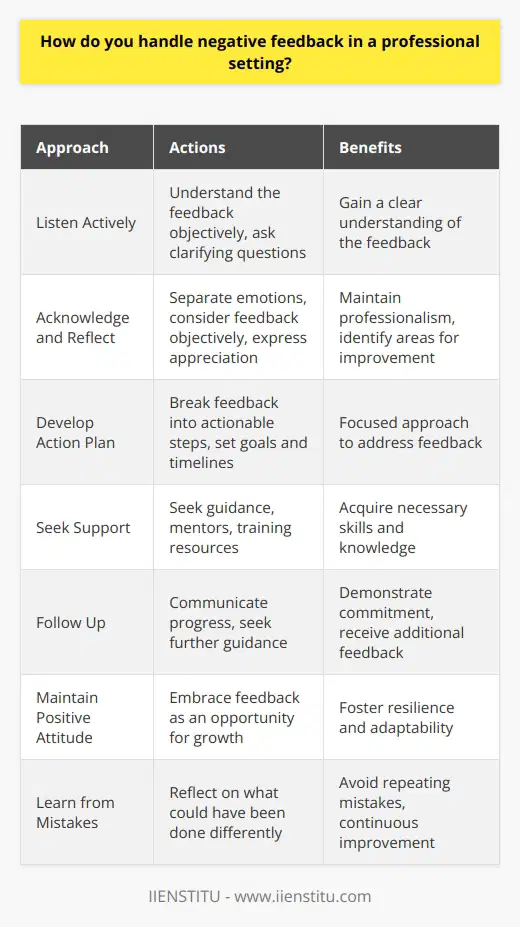
What strategies do you employ to effectively respond to constructive criticism in the workplace?
Responding to constructive criticism in the workplace is a crucial skill for professional growth and maintaining positive relationships. Employing effective strategies can help individuals navigate feedback productively and improve their performance. This paragraph explores various approaches to handling constructive criticism in a professional setting.
Embrace a Growth Mindset
Adopting a growth mindset is essential when receiving constructive criticism. Recognize that feedback is an opportunity for improvement and personal development. Approach criticism with an open mind and a willingness to learn from others' perspectives. Embracing this mindset shifts the focus from defensiveness to growth.
Active Listening
Practice active listening when receiving constructive criticism. Give your full attention to the person providing the feedback. Avoid interrupting or formulating responses while they are speaking. Concentrate on understanding their perspective and the reasoning behind their comments. Active listening demonstrates respect and facilitates effective communication.
Seek Clarification
If any aspect of the constructive criticism is unclear, seek clarification. Ask questions to gain a better understanding of the feedback. Request specific examples or suggestions for improvement. Clarification ensures that you grasp the full context and implications of the criticism, enabling you to address it effectively.
Manage Emotions
Receiving criticism can evoke various emotions, such as defensiveness, frustration, or embarrassment. Manage these emotions by taking a step back and processing the feedback objectively. Take a deep breath and maintain a calm and professional demeanor. Avoid reacting impulsively or allowing emotions to cloud your judgment.
Reflect and Evaluate
After receiving constructive criticism, take time to reflect on the feedback. Evaluate its validity and relevance to your work. Consider how the suggestions align with your goals and the company's objectives. Reflection allows you to gain insights, identify areas for improvement, and develop a plan of action.
Express Gratitude
Acknowledge and express gratitude for the constructive criticism. Thank the person for taking the time to provide feedback. Recognize their intention to help you grow and improve. Expressing gratitude fosters a positive and receptive atmosphere, encouraging open communication and continuous feedback.
Create an Action Plan
Based on the constructive criticism, create a concrete action plan for improvement. Break down the feedback into specific, measurable steps. Set goals and timelines for implementing the suggested changes. Regularly review your progress and seek further guidance if needed. An action plan demonstrates your commitment to growth and accountability.
Follow Up
After implementing the feedback, follow up with the person who provided the constructive criticism. Share your progress, successes, and any challenges you encountered. Seek their input on your improvement and any further suggestions they may have. Following up shows your dedication to personal development and strengthens professional relationships.
By employing these strategies, individuals can effectively respond to constructive criticism in the workplace. Embracing feedback, actively listening, seeking clarification, managing emotions, reflecting, expressing gratitude, creating action plans, and following up are key components of navigating criticism productively. Implementing these approaches fosters personal growth, enhances performance, and contributes to a positive and collaborative work environment.
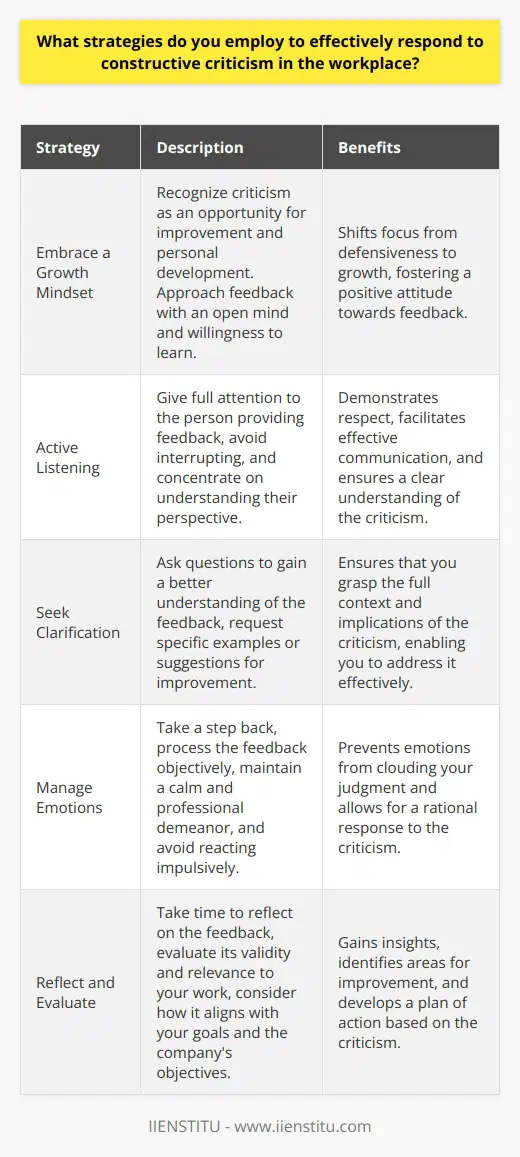
In what ways do you use feedback to improve your performance and grow professionally?
Feedback plays a crucial role in personal and professional growth, enabling individuals to identify areas for improvement and make necessary adjustments. By actively seeking and incorporating feedback from various sources, such as supervisors, colleagues, and mentors, one can gain valuable insights into their strengths and weaknesses. This information can then be used to develop targeted strategies for enhancing performance and acquiring new skills.
Soliciting Feedback
To effectively utilize feedback for growth, it is essential to proactively seek input from others. This can be done by requesting regular performance reviews, participating in 360-degree feedback processes, and engaging in open discussions with team members. By demonstrating a willingness to receive constructive criticism and a genuine desire to improve, individuals can create an environment that encourages honest and valuable feedback.
Analyzing Feedback
Once feedback is received, it is crucial to carefully analyze and reflect upon the information provided. This involves identifying patterns or recurring themes in the feedback, as well as distinguishing between subjective opinions and objective observations. By critically examining the feedback, individuals can gain a clearer understanding of their performance and pinpoint specific areas that require attention.
Setting Goals and Action Plans
Armed with insights gained from feedback, individuals can set clear and measurable goals for improvement. These goals should be specific, achievable, and aligned with personal and professional aspirations. By breaking down larger objectives into smaller, actionable steps, individuals can create a roadmap for growth and development.
Implementing Strategies
To successfully achieve growth goals, it is necessary to implement targeted strategies and interventions. This may involve seeking additional training or mentorship, practicing new skills, or modifying existing approaches. By consistently applying these strategies and monitoring progress, individuals can gradually enhance their performance and expand their capabilities.
Continuous Learning
Feedback-driven growth is an ongoing process that requires a commitment to continuous learning and self-improvement. By regularly seeking feedback, reflecting on experiences, and adapting to new challenges, individuals can cultivate a growth mindset and embrace opportunities for personal and professional development.
Celebrating Successes
As individuals make progress towards their growth goals, it is important to acknowledge and celebrate successes along the way. Recognizing achievements, no matter how small, can boost motivation and reinforce the value of feedback-driven growth. By appreciating the progress made and the lessons learned, individuals can maintain momentum and continue to strive for excellence.
In conclusion, feedback serves as a powerful catalyst for personal and professional growth. By actively seeking, analyzing, and incorporating feedback into goal-setting and skill-building processes, individuals can unlock their full potential and achieve sustained success in their chosen fields.
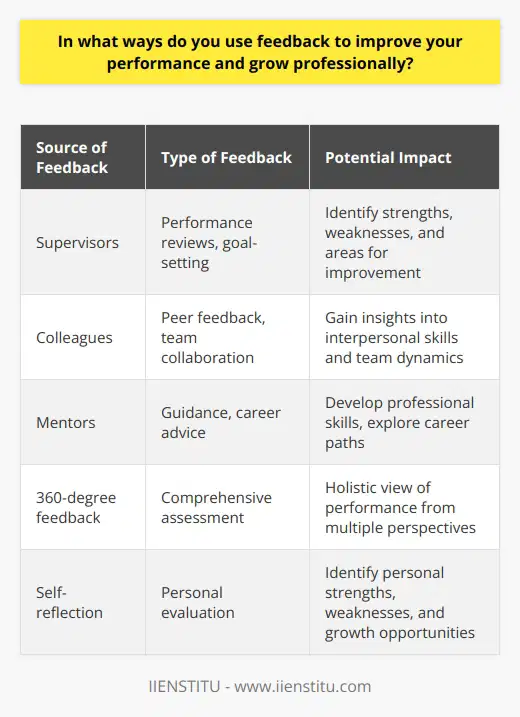
How do you handle negative feedback in a digital marketing campaign?
Handling negative feedback in a digital marketing campaign requires a proactive and strategic approach. It is essential to monitor and address negative comments promptly and professionally. Ignoring negative feedback can lead to a damaged reputation and a loss of potential customers.
Acknowledge and Respond
When you receive negative feedback, acknowledge the customer's concerns and respond in a timely manner. Show empathy and understanding, and thank them for bringing the issue to your attention. Offer a sincere apology if necessary and provide a solution or explanation to address their concerns.
Take the Conversation Offline
If the negative feedback is complex or sensitive, consider taking the conversation offline. Provide the customer with a direct contact method, such as an email address or phone number, to discuss the issue further. This approach demonstrates your commitment to resolving the problem and prevents the conversation from escalating in a public forum.
Analyze and Learn
Treat negative feedback as an opportunity to learn and improve your digital marketing campaign. Analyze the feedback to identify patterns or recurring issues. Use this information to make necessary adjustments to your strategy, messaging, or product offerings.
Encourage Positive Reviews
Encourage satisfied customers to leave positive reviews and testimonials. Positive feedback can help counterbalance negative comments and enhance your brand's online reputation. Make it easy for customers to leave reviews by providing links or instructions on your website and social media profiles.
Monitor and Prevent
Regularly monitor your digital marketing channels for negative feedback. Set up alerts or use monitoring tools to stay informed about mentions of your brand or campaign. By identifying negative feedback early, you can address issues before they escalate and prevent potential damage to your reputation.
Train Your Team
Ensure that your team is trained to handle negative feedback effectively. Provide them with guidelines on how to respond to negative comments, escalate issues when necessary, and maintain a professional and empathetic tone. Consistent and appropriate responses from your team can help mitigate the impact of negative feedback.
Learn from Competitors
Observe how your competitors handle negative feedback in their digital marketing campaigns. Take note of effective strategies and learn from their mistakes. Adapt and improve upon their approaches to strengthen your own feedback management process.
Maintain Transparency
Be transparent and honest in your communications with customers. If a mistake was made, own up to it and explain how you plan to rectify the situation. Transparency builds trust and credibility, which can help mitigate the impact of negative feedback.
Focus on Continuous Improvement
Use negative feedback as a catalyst for continuous improvement. Regularly assess your digital marketing campaign's performance and make data-driven decisions to optimize your strategies. By consistently enhancing your campaign based on customer feedback, you can reduce the likelihood of receiving negative comments in the future.
In conclusion, handling negative feedback in a digital marketing campaign requires a combination of proactive monitoring, prompt response, analysis, and continuous improvement. By addressing negative comments professionally and using them as opportunities for growth, you can maintain a positive brand reputation and build stronger relationships with your customers.
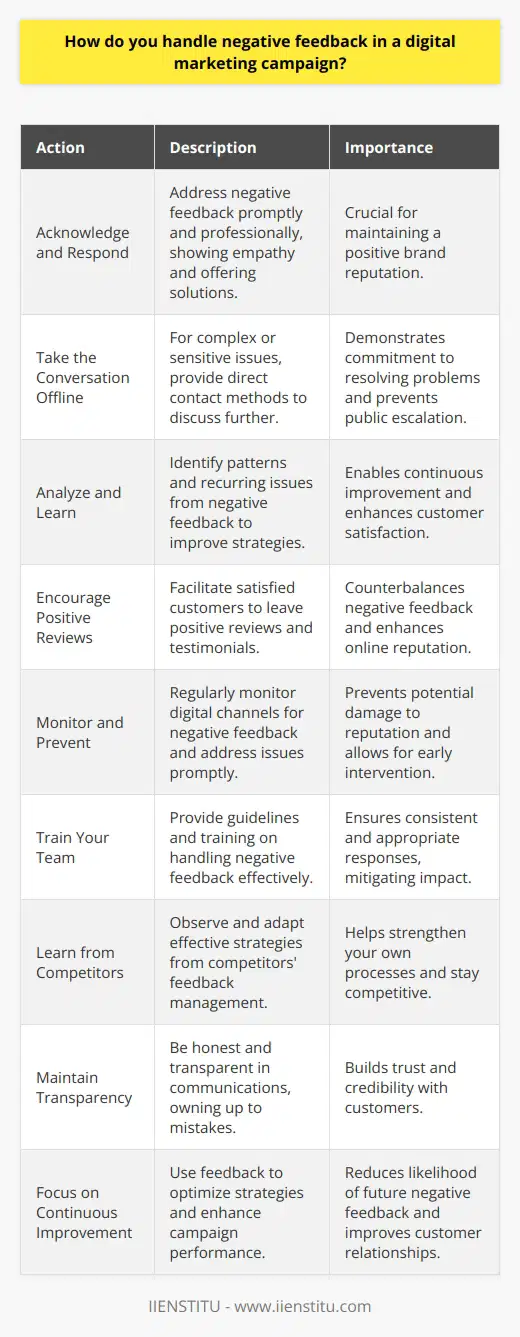
What strategies would you employ to measure the success of a digital marketing initiative?
Measuring the success of a digital marketing initiative requires a comprehensive approach that incorporates various metrics and analytics. To effectively gauge the performance of a digital marketing campaign, marketers should establish clear objectives and key performance indicators (KPIs) aligned with their overall business goals. These KPIs may include website traffic, conversion rates, engagement metrics, and return on investment (ROI).
Setting Clear Objectives and KPIs
Before launching a digital marketing initiative, it is crucial to define specific, measurable, achievable, relevant, and time-bound (SMART) objectives. These objectives should directly contribute to the company's broader marketing and business goals. By setting clear KPIs, marketers can track progress and make data-driven decisions to optimize their campaigns.
Website Traffic and Engagement Metrics
Analyzing website traffic is a fundamental strategy for measuring the success of a digital marketing initiative. Marketers should monitor metrics such as unique visitors, page views, bounce rate, and average session duration. These metrics provide insights into the effectiveness of the campaign in attracting and engaging the target audience.
Conversion Tracking
Conversion tracking is essential to determine the effectiveness of a digital marketing campaign in driving desired actions. Marketers should define specific conversion goals, such as form submissions, purchases, or sign-ups, and track their completion rates. By monitoring conversion rates, marketers can identify areas for improvement and optimize their campaigns accordingly.
Social Media Metrics
Social media platforms offer valuable insights into the performance of a digital marketing initiative. Marketers should track metrics such as followers, likes, shares, comments, and click-through rates. These metrics indicate the level of engagement and reach of the campaign on social media channels.
Return on Investment (ROI) Analysis
Measuring the ROI of a digital marketing initiative is critical to justifying the investment and making informed decisions. Marketers should calculate the ROI by comparing the revenue generated from the campaign to the total cost of the initiative. This analysis helps determine the profitability and effectiveness of the marketing efforts.
A/B Testing and Optimization
A/B testing is a powerful strategy for optimizing digital marketing campaigns. By comparing two or more versions of a marketing asset, such as an email subject line or landing page, marketers can determine which version performs better. A/B testing allows for data-driven optimization and continuous improvement of the marketing initiative.
Customer Feedback and Surveys
Gathering customer feedback through surveys and interviews provides valuable qualitative insights into the success of a digital marketing initiative. Marketers can ask customers about their experience, satisfaction, and likelihood to recommend the brand. This feedback helps identify areas for improvement and enhances the overall customer experience.
In conclusion, measuring the success of a digital marketing initiative requires a holistic approach that combines quantitative and qualitative metrics. By setting clear objectives, tracking relevant KPIs, analyzing ROI, conducting A/B tests, and gathering customer feedback, marketers can gain a comprehensive understanding of their campaign's performance and make data-driven decisions to optimize their digital marketing efforts.
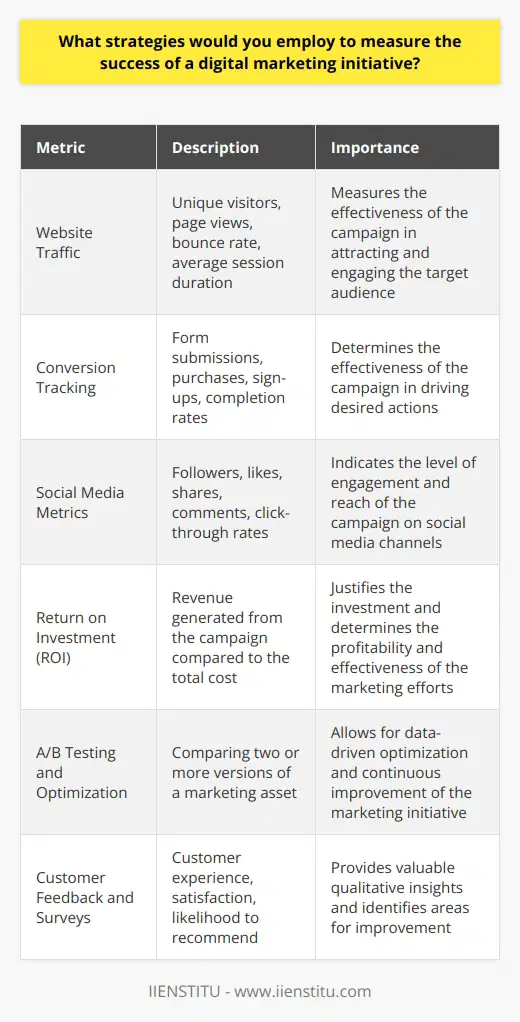
In your opinion, what are the most critical skills for a fresher to succeed in a digital marketing role?
In my opinion, several critical skills are essential for a fresher to succeed in a digital marketing role. First and foremost, a strong understanding of digital marketing concepts and strategies is crucial. This includes knowledge of search engine optimization (SEO), pay-per-click (PPC) advertising, social media marketing, content marketing, and email marketing. A fresher should be familiar with the latest trends and best practices in these areas to effectively promote products or services online.
Analytical Skills
Analytical skills are also vital for success in digital marketing. A fresher should be able to analyze data from various digital marketing campaigns and use that information to make data-driven decisions. This involves understanding metrics such as website traffic, conversion rates, bounce rates, and engagement rates. By analyzing this data, a fresher can identify areas for improvement and optimize campaigns for better results.
Creativity and Innovation
Creativity and innovation are essential skills for a fresher in digital marketing. In a highly competitive online landscape, it's important to stand out from the crowd and capture the attention of potential customers. A fresher should be able to think outside the box and develop creative ideas for marketing campaigns that engage and resonate with the target audience. This could involve creating compelling ad copy, designing eye-catching graphics, or developing interactive content that encourages user participation.
Adaptability and Flexibility
The digital marketing landscape is constantly evolving, with new technologies and platforms emerging regularly. A fresher should be adaptable and flexible, willing to learn and embrace new tools and strategies as they arise. This requires a curiosity and willingness to experiment with new approaches, as well as the ability to pivot quickly when something isn't working.
Communication and Collaboration
Effective communication and collaboration skills are also important for a fresher in digital marketing. Digital marketing often involves working with a team of professionals, including designers, developers, and content creators. A fresher should be able to communicate clearly and effectively with team members, as well as with clients or stakeholders. This involves being able to articulate ideas, provide feedback, and work collaboratively towards a common goal.
Time Management and Organization
Finally, time management and organization skills are critical for success in digital marketing. Digital marketing campaigns often involve multiple moving parts and tight deadlines. A fresher should be able to manage their time effectively, prioritize tasks, and stay organized to ensure that campaigns are executed smoothly and efficiently. This involves being able to work well under pressure, multitask, and meet deadlines consistently.
Continuous Learning and Professional Development
In addition to these skills, a fresher in digital marketing should also be committed to continuous learning and professional development. The digital marketing landscape is constantly evolving, and it's important to stay up-to-date with the latest trends, technologies, and best practices. This could involve attending industry conferences, participating in online courses or webinars, or reading relevant blogs and publications.
In conclusion, success in a digital marketing role requires a combination of technical skills, analytical abilities, creativity, adaptability, communication, and organization. By developing these skills and staying committed to continuous learning and professional development, a fresher can position themselves for success in this exciting and dynamic field.
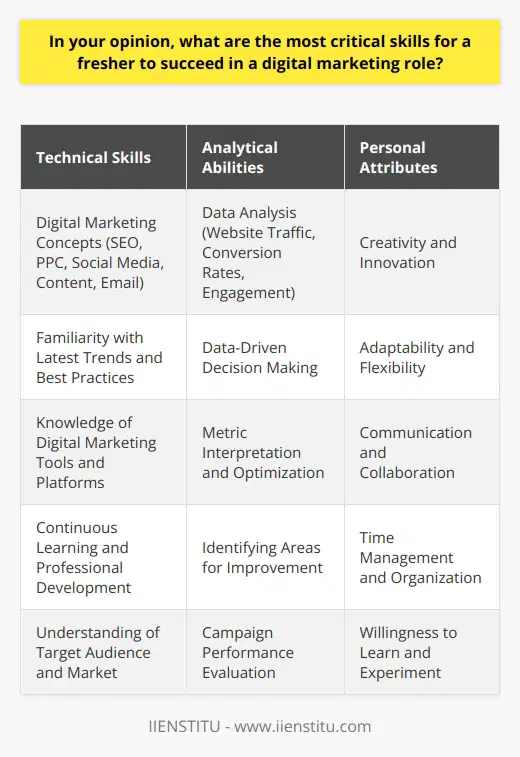
What are some common digital marketing interview questions and their appropriate answers?
Digital marketing interviews often cover a range of topics, from basic concepts to more advanced strategies and techniques. Some common questions that may arise during a digital marketing interview include:
1. What is your experience with SEO?
When answering this question, discuss your knowledge of search engine optimization techniques, such as keyword research, on-page optimization, and link building. Provide examples of successful SEO campaigns you have worked on and the results achieved.
2. How do you measure the success of a digital marketing campaign?
Explain the key performance indicators (KPIs) you use to track the effectiveness of a digital marketing campaign. These may include website traffic, conversion rates, engagement metrics, and return on investment (ROI). Demonstrate your ability to analyze data and make data-driven decisions.
3. What social media platforms do you have experience with?
Discuss the social media platforms you are proficient in, such as Facebook, Twitter, Instagram, and LinkedIn. Explain how you have used these platforms to engage with target audiences, build brand awareness, and drive traffic to websites.
4. How do you stay up-to-date with the latest digital marketing trends?
Showcase your passion for learning and staying current in the ever-evolving digital marketing landscape. Mention industry blogs, podcasts, or conferences you follow to stay informed about new trends, technologies, and best practices.
5. Can you describe a successful email marketing campaign you have executed?
Share an example of an email marketing campaign you have developed and implemented. Discuss the goals of the campaign, the target audience, the content strategy, and the results achieved. Highlight your ability to create compelling email content and analyze campaign performance.
6. How do you approach content creation for different target audiences?
Explain your process for developing content that resonates with specific target audiences. Discuss how you conduct audience research, identify key messaging points, and tailor content to different buyer personas. Emphasize your ability to create engaging and informative content across various formats, such as blog posts, videos, and infographics.
7. What experience do you have with paid advertising campaigns?
Discuss your knowledge of paid advertising platforms, such as Google Ads, Facebook Ads, and LinkedIn Ads. Explain how you develop and optimize ad campaigns, set budgets, and track performance. Provide examples of successful paid advertising campaigns you have managed and the ROI achieved.
When answering these questions, it is important to provide specific examples and data to support your responses. Demonstrate your strategic thinking, creativity, and analytical skills. Showcase your passion for digital marketing and your ability to drive meaningful results for businesses.

How can one effectively prepare for a digital marketing interview and showcase their skills and knowledge?
To effectively prepare for a digital marketing interview and showcase your skills and knowledge, consider the following strategies:
Research the Company and Role
Before the interview, thoroughly research the company and the specific role you are applying for. This will help you understand the company's goals, target audience, and marketing strategies. Use this information to tailor your responses and demonstrate your understanding of the industry.
Review Digital Marketing Concepts
Brush up on your knowledge of digital marketing concepts, such as SEO, PPC, social media marketing, and content marketing. Be prepared to discuss how you have applied these concepts in your previous experiences and how you can contribute to the company's marketing efforts.
Analyze Your Previous Work
Review your portfolio and previous projects to identify specific examples that showcase your skills and achievements. Be ready to discuss the strategies you implemented, the challenges you faced, and the results you achieved. Use data and metrics to support your claims and demonstrate your impact.
Prepare Questions for the Interviewer
Demonstrate your interest in the company and the role by preparing thoughtful questions for the interviewer. Ask about the company's marketing goals, current challenges, and opportunities for growth. This will show that you are proactive and eager to contribute to the team.
Practice Your Communication Skills
Effective communication is crucial in digital marketing. Practice articulating your thoughts clearly and concisely. Use examples and analogies to explain complex concepts and showcase your ability to communicate with both technical and non-technical audiences.
Highlight Your Adaptability
Digital marketing is a constantly evolving field. Emphasize your ability to adapt to new technologies, platforms, and strategies. Share examples of how you have stayed up-to-date with industry trends and applied new knowledge to your work.
Showcase Your Creativity
Digital marketing often requires creative problem-solving. Share examples of how you have developed innovative marketing campaigns or solved complex challenges. Highlight your ability to think outside the box and develop unique solutions that drive results.
Demonstrate Your Collaboration Skills
Digital marketing often involves working with cross-functional teams. Discuss your experience collaborating with designers, developers, and other stakeholders. Share examples of how you have successfully contributed to team projects and fostered positive working relationships.
Be Confident and Authentic
Finally, be confident in your abilities and authentic in your responses. Share your passion for digital marketing and your desire to contribute to the company's success. By showcasing your skills, knowledge, and enthusiasm, you will make a strong impression on the interviewer and increase your chances of landing the job.
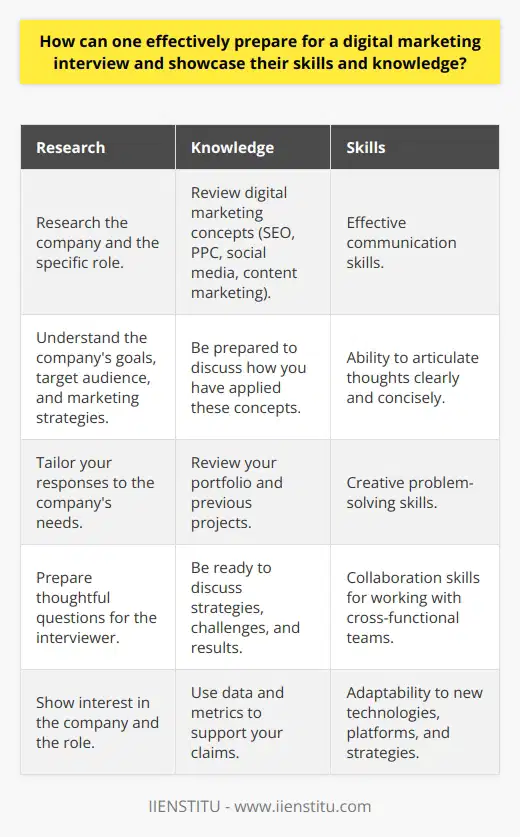
What are the most important aspects of digital marketing that interviewers typically focus on during the question and answer process?
Interviewers typically focus on several key aspects of digital marketing during the question and answer process. These aspects include the candidate's understanding of various digital marketing channels and their effectiveness. Interviewers also assess the candidate's ability to develop and execute comprehensive digital marketing strategies. Additionally, they evaluate the candidate's proficiency in analyzing and interpreting data to make informed decisions and optimize campaigns.
Understanding of Digital Marketing Channels
Interviewers gauge the candidate's knowledge of different digital marketing channels such as search engine optimization (SEO), pay-per-click (PPC) advertising, social media marketing, email marketing, and content marketing. They expect candidates to demonstrate a deep understanding of how each channel works and their respective strengths and limitations. Candidates should be able to explain how these channels contribute to overall digital marketing goals and objectives.
Developing and Executing Digital Marketing Strategies
Interviewers assess the candidate's ability to develop and execute comprehensive digital marketing strategies. They look for candidates who can identify target audiences, set clear goals, and create actionable plans to achieve those goals. Candidates should showcase their skills in selecting the most appropriate channels, allocating budgets, and managing resources effectively. They should also demonstrate their ability to adapt strategies based on performance data and changing market conditions.
Data Analysis and Interpretation
Interviewers place significant emphasis on the candidate's proficiency in analyzing and interpreting data. They expect candidates to be comfortable working with various analytics tools and metrics. Candidates should be able to collect and analyze data from different sources, identify trends and patterns, and derive meaningful insights. They should also demonstrate their ability to use data to make informed decisions, optimize campaigns, and measure the success of digital marketing efforts.
Staying Updated with Industry Trends and Best Practices
Interviewers value candidates who stay updated with the latest industry trends and best practices. They expect candidates to have a deep understanding of the ever-evolving digital marketing landscape. Candidates should be knowledgeable about emerging technologies, changes in algorithms, and shifts in consumer behavior. They should also demonstrate their ability to adapt to these changes and incorporate new strategies and tactics into their digital marketing approaches.
Collaboration and Communication Skills
Interviewers assess the candidate's ability to collaborate and communicate effectively with cross-functional teams. Digital marketing often involves working closely with various departments such as sales, product development, and customer service. Candidates should showcase their skills in building strong relationships, facilitating seamless communication, and fostering a collaborative work environment. They should also demonstrate their ability to clearly articulate complex ideas and concepts to both technical and non-technical stakeholders.
Problem-Solving and Creativity
Interviewers look for candidates who possess strong problem-solving skills and creativity. Digital marketing often presents unique challenges that require innovative solutions. Candidates should showcase their ability to think outside the box, generate fresh ideas, and develop creative strategies to overcome obstacles. They should also demonstrate their problem-solving skills by sharing examples of how they have successfully tackled complex challenges in their previous roles.
In conclusion, interviewers focus on various aspects of digital marketing during the question and answer process. They assess the candidate's understanding of digital marketing channels, ability to develop and execute strategies, proficiency in data analysis, knowledge of industry trends, collaboration and communication skills, and problem-solving and creativity. Candidates who can demonstrate expertise in these areas and provide relevant examples from their experience are more likely to succeed in digital marketing interviews.

What are the most important skills for a successful digital marketer?
Digital marketing is a rapidly evolving field that requires a diverse set of skills to succeed. A successful digital marketer must possess a combination of technical, creative, and analytical abilities to effectively promote products or services online. Here are some of the most important skills for a successful digital marketer:
1. Content Creation
Digital marketers must be skilled in creating engaging and informative content across various platforms. This includes writing blog posts, social media updates, email newsletters, and ad copy. The ability to craft compelling content that resonates with the target audience is crucial for attracting and retaining customers.
2. Search Engine Optimization (SEO)
SEO is the practice of optimizing websites and content to rank higher in search engine results pages. Digital marketers must understand how search engines work and be able to implement effective SEO strategies. This includes keyword research, on-page optimization, link building, and monitoring search engine rankings.
3. Social Media Marketing
Social media platforms like Facebook, Twitter, and Instagram are powerful tools for reaching and engaging with customers. Digital marketers must be proficient in creating and managing social media campaigns, as well as analyzing their performance. This includes developing content calendars, monitoring social media metrics, and responding to customer inquiries and feedback.
4. Email Marketing
Email marketing is a highly effective way to nurture leads and build customer loyalty. Digital marketers must be skilled in creating and managing email campaigns, as well as analyzing their performance. This includes developing email templates, segmenting email lists, and tracking open and click-through rates.
5. Analytics and Data Analysis
Digital marketers must be able to analyze data from various sources to make informed decisions about their marketing strategies. This includes web analytics, social media metrics, and customer data. The ability to interpret data and use it to optimize campaigns is essential for maximizing return on investment (ROI).
6. Pay-Per-Click (PPC) Advertising
PPC advertising is a form of online advertising where advertisers pay each time a user clicks on one of their ads. Digital marketers must be skilled in creating and managing PPC campaigns, as well as analyzing their performance. This includes keyword research, ad copywriting, bid management, and conversion tracking.
7. Customer Relationship Management (CRM)
CRM involves managing interactions with current and potential customers to improve business relationships and drive sales growth. Digital marketers must be proficient in using CRM software to manage customer data, track customer interactions, and personalize marketing messages.
In conclusion, a successful digital marketer must possess a wide range of skills to effectively promote products or services online. These skills include content creation, SEO, social media marketing, email marketing, analytics and data analysis, PPC advertising, and customer relationship management. By mastering these skills, digital marketers can create effective campaigns that drive traffic, generate leads, and increase sales.

How do you measure the effectiveness of a digital marketing campaign?
Measuring the effectiveness of a digital marketing campaign involves analyzing various metrics and key performance indicators (KPIs). These metrics help determine whether the campaign is achieving its desired goals and objectives. Some essential metrics to consider when measuring the success of a digital marketing campaign include website traffic, engagement rates, conversion rates, and return on investment (ROI).
Website Traffic
Website traffic is a fundamental metric to track when measuring the effectiveness of a digital marketing campaign. It indicates the number of visitors your website receives as a result of the campaign. Tools like Google Analytics can help monitor website traffic, providing insights into the number of unique visitors, page views, and average time spent on the site. An increase in website traffic suggests that the campaign is successfully attracting audience attention.
Engagement Rates
Engagement rates measure how actively users interact with your digital marketing content. This includes metrics such as likes, shares, comments, and click-through rates (CTR) on social media platforms, email newsletters, or advertisements. High engagement rates indicate that the campaign's content resonates with the target audience, fostering a sense of connection and interest in the brand or product.
Social Media Metrics
Social media platforms offer built-in analytics that track engagement rates specific to each platform. These metrics help assess the campaign's reach, audience growth, and content performance on social media channels.
Email Marketing Metrics
For email marketing campaigns, metrics like open rates, click-through rates, and unsubscribe rates are crucial. They provide insights into the effectiveness of email subject lines, content relevance, and overall subscriber engagement.
Conversion Rates
Conversion rates measure the percentage of visitors who take the desired action, such as making a purchase, filling out a form, or subscribing to a newsletter. Tracking conversion rates helps determine whether the campaign is effectively guiding users through the sales funnel and achieving its ultimate goals. A high conversion rate indicates that the campaign is successfully persuading visitors to take the intended action.
Return on Investment (ROI)
ROI is a critical metric that compares the revenue generated from the digital marketing campaign to the cost of implementing it. To calculate ROI, divide the net profit by the total campaign cost and multiply by 100. A positive ROI indicates that the campaign is generating more revenue than its cost, while a negative ROI suggests the need for optimization or reevaluation of the campaign strategy.
A/B Testing
A/B testing involves comparing two versions of a digital marketing asset, such as an email subject line, ad copy, or landing page, to determine which performs better. By conducting A/B tests, marketers can optimize their campaigns based on data-driven insights, ensuring that the most effective elements are used to maximize results.
To effectively measure the success of a digital marketing campaign, it is essential to set clear goals and KPIs from the outset. Regularly monitoring and analyzing the aforementioned metrics throughout the campaign allows for timely adjustments and optimizations. By leveraging data-driven insights, marketers can make informed decisions to enhance the effectiveness of their digital marketing efforts and achieve their desired outcomes.

What strategies would you recommend for improving a company's online presence and driving more traffic to their website?
To improve a company's online presence and drive more traffic to their website, several strategies can be implemented. First, the company should focus on search engine optimization (SEO) to increase its visibility in search results. This involves researching relevant keywords and incorporating them naturally into the website's content, meta tags, and URLs. Additionally, creating high-quality, engaging content that addresses the target audience's needs and interests is crucial for attracting and retaining visitors.
Leverage Social Media
Social media platforms provide excellent opportunities to connect with potential customers and drive traffic to the company's website. The company should establish a strong presence on relevant social media channels and regularly post engaging content that encourages users to visit their website. Utilizing paid social media advertising can also help target specific demographics and increase brand awareness.
Collaborate with Influencers
Partnering with influencers in the company's industry can help expand its reach and attract new visitors to the website. Influencers can create sponsored content, reviews, or mentions of the company's products or services, driving their followers to the company's website. It is essential to choose influencers whose values and target audience align with the company's brand.
Implement Email Marketing
Email marketing is an effective way to nurture leads and keep the company's audience engaged. Building an email list of subscribers interested in the company's offerings allows for targeted communication and encourages repeat visits to the website. Regularly sending newsletters, promotional offers, and valuable content can help maintain a strong connection with the audience and drive traffic to the website.
Optimize for Mobile Devices
With the increasing use of mobile devices for web browsing, it is crucial to ensure that the company's website is mobile-friendly. Implementing a responsive design that adapts to different screen sizes and optimizing page load times can improve the user experience and reduce bounce rates. A mobile-friendly website is also favored by search engines, potentially improving the company's search rankings.
Engage in Content Marketing
Content marketing involves creating and distributing valuable, relevant content to attract and retain a clearly defined audience. By consistently producing informative blog posts, videos, infographics, or whitepapers, the company can establish itself as a thought leader in its industry. This not only attracts organic traffic to the website but also encourages other websites to link back to the company's content, improving its search engine rankings.
Utilize Pay-Per-Click Advertising
Pay-per-click (PPC) advertising, such as Google Ads, can provide immediate visibility and drive targeted traffic to the company's website. By creating compelling ad copy and targeting relevant keywords, the company can attract potential customers actively searching for products or services similar to what the company offers. However, it is essential to continuously monitor and optimize PPC campaigns to ensure a positive return on investment.
Analyze and Adapt
To continually improve the company's online presence and drive more traffic, it is crucial to regularly analyze website performance and user behavior. Utilizing tools like Google Analytics can provide valuable insights into traffic sources, user engagement, and conversion rates. Based on this data, the company can make informed decisions to refine its strategies and adapt to changing audience preferences and market trends.
By implementing a combination of these strategies and continuously monitoring and adapting their approach, a company can effectively improve its online presence and drive more qualified traffic to its website. Consistency, patience, and a focus on providing value to the target audience are key to achieving long-term success in the digital landscape.

What are your strengths and weaknesses, and how do they relate to your professional goals?
Identifying and understanding one's strengths and weaknesses is crucial for setting and achieving professional goals. Strengths are the qualities and skills that enable an individual to excel in certain areas, while weaknesses are the areas that require improvement. By recognizing and leveraging strengths, one can maximize their potential and contribute effectively to their chosen field. Conversely, acknowledging weaknesses allows for targeted growth and development, ultimately enhancing overall performance.
Leveraging Strengths for Professional Success
Strengths serve as the foundation for professional success. They are the unique abilities and traits that set an individual apart from others. By identifying and focusing on strengths, one can align their career path with their natural talents and passions. This alignment leads to increased job satisfaction, motivation, and productivity. For example, if communication is a strength, pursuing roles that involve public speaking or client interaction can lead to fulfillment and success.
Moreover, leveraging strengths allows individuals to make valuable contributions to their team and organization. When strengths are utilized effectively, they can drive innovation, solve complex problems, and create positive outcomes. Recognizing and showcasing strengths during job interviews and performance evaluations can also open doors to new opportunities and advancement within a chosen field.
Addressing Weaknesses for Continuous Growth
While focusing on strengths is essential, addressing weaknesses is equally important for professional development. Weaknesses are areas that may hinder performance or limit growth if left unaddressed. By openly acknowledging weaknesses, individuals demonstrate self-awareness and a willingness to improve. This mindset fosters a growth-oriented approach to personal and professional development.
Identifying weaknesses allows for targeted skill development and learning opportunities. Seeking feedback from colleagues, mentors, or supervisors can provide valuable insights into areas that require attention. Engaging in training programs, workshops, or mentorship can help bridge skill gaps and enhance overall competence. By consistently working on weaknesses, individuals can overcome obstacles and become well-rounded professionals.
Aligning Strengths and Weaknesses with Professional Goals
Understanding the interplay between strengths, weaknesses, and professional goals is crucial for long-term success. Professional goals should align with an individual's strengths, allowing them to leverage their natural abilities to achieve desired outcomes. For instance, if problem-solving is a strength, setting goals related to tackling complex challenges or leading innovative projects can be highly motivating and rewarding.
Simultaneously, professional goals should also consider weaknesses and include strategies for improvement. If public speaking is a weakness, setting a goal to deliver presentations or lead meetings can help overcome the challenge. By incorporating weaknesses into goal-setting, individuals create opportunities for personal growth and development, ultimately enhancing their overall professional profile.
Conclusion
Recognizing and understanding strengths and weaknesses is a critical aspect of professional development. By leveraging strengths, individuals can maximize their potential and make valuable contributions to their field. Addressing weaknesses, on the other hand, enables continuous growth and improvement. Aligning strengths and weaknesses with professional goals creates a roadmap for success, allowing individuals to pursue a fulfilling and rewarding career path.
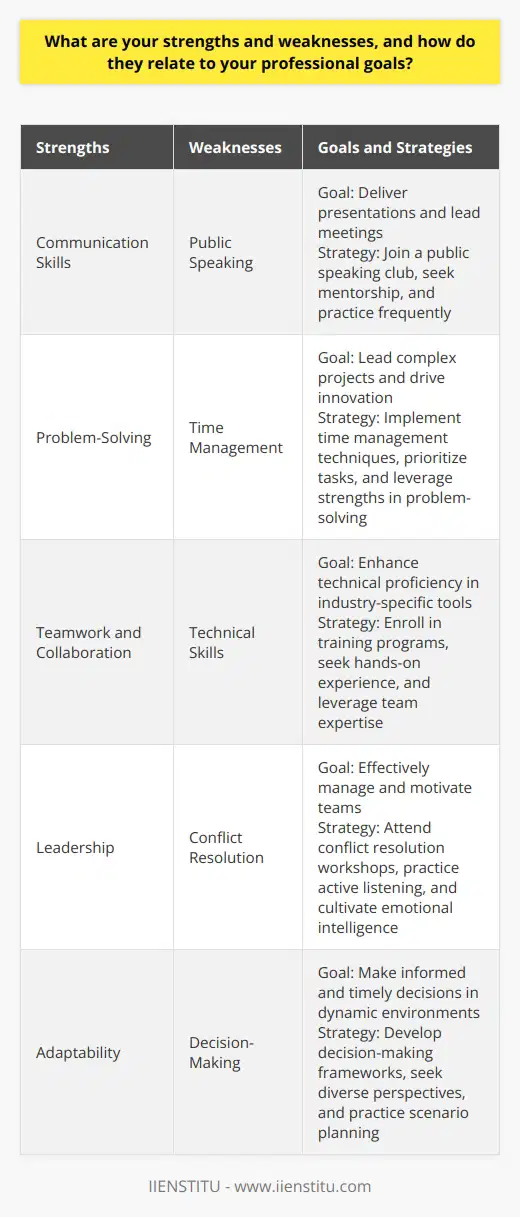
How do you stay current with the latest digital marketing trends and best practices?
Staying current with the latest digital marketing trends and best practices is crucial for marketers to remain competitive. In the fast-paced digital landscape, new technologies, platforms, and strategies emerge rapidly. To stay informed, marketers should adopt a proactive approach to learning and professional development. This involves regularly consuming content from industry thought leaders, attending conferences and webinars, and participating in online communities.
Consume Industry Content
One effective way to stay current is to consume content from reputable industry sources. Subscribe to newsletters, blogs, and podcasts that cover digital marketing topics. Follow influential marketers and industry experts on social media platforms like Twitter and LinkedIn. Set aside dedicated time each week to read articles, watch videos, and listen to podcasts. This habit will help you stay informed about the latest trends, case studies, and best practices.
Attend Conferences and Webinars
Attending conferences and webinars is another valuable way to stay current. Industry events bring together experts, practitioners, and thought leaders to share insights and experiences. They provide opportunities to learn about cutting-edge strategies, network with peers, and gain exposure to new ideas. Many conferences now offer virtual attendance options, making them more accessible. Webinars are also a convenient way to learn from experts without leaving your desk.
Participate in Online Communities
Engaging in online communities is a great way to stay connected with fellow marketers. Join relevant groups on platforms like Facebook, LinkedIn, and Slack. Participate in discussions, ask questions, and share your own experiences. These communities often feature valuable content, resources, and job opportunities. They also provide a space to collaborate with others, seek advice, and stay motivated.
Experiment and Test
To truly stay current, it's important to move beyond consuming information and start applying it. Experiment with new strategies and tactics in your own marketing efforts. Conduct A/B tests to optimize your campaigns. Analyze data to measure the effectiveness of your approaches. By actively testing and iterating, you'll gain firsthand experience with the latest trends and best practices.
Invest in Professional Development
Investing in your own professional development is essential for staying current. Consider enrolling in online courses, workshops, or certification programs. Many reputable institutions offer digital marketing courses that cover various aspects of the field. These programs provide structured learning experiences, practical exercises, and opportunities to network with other professionals. Continuously expanding your skillset will help you stay ahead of the curve.
Embrace a Growth Mindset
Staying current in digital marketing requires a growth mindset. Embrace the idea that learning is a lifelong pursuit. Be open to new ideas, even if they challenge your existing beliefs. Don't be afraid to experiment, make mistakes, and learn from them. Cultivate curiosity and a willingness to adapt to change. By adopting a growth mindset, you'll be better equipped to navigate the ever-evolving digital marketing landscape.
In conclusion, staying current with digital marketing trends and best practices is an ongoing process. It involves consuming industry content, attending events, participating in communities, experimenting, investing in professional development, and embracing a growth mindset. By dedicating time and effort to continuous learning, marketers can stay ahead of the curve and deliver effective strategies in the dynamic world of digital marketing.
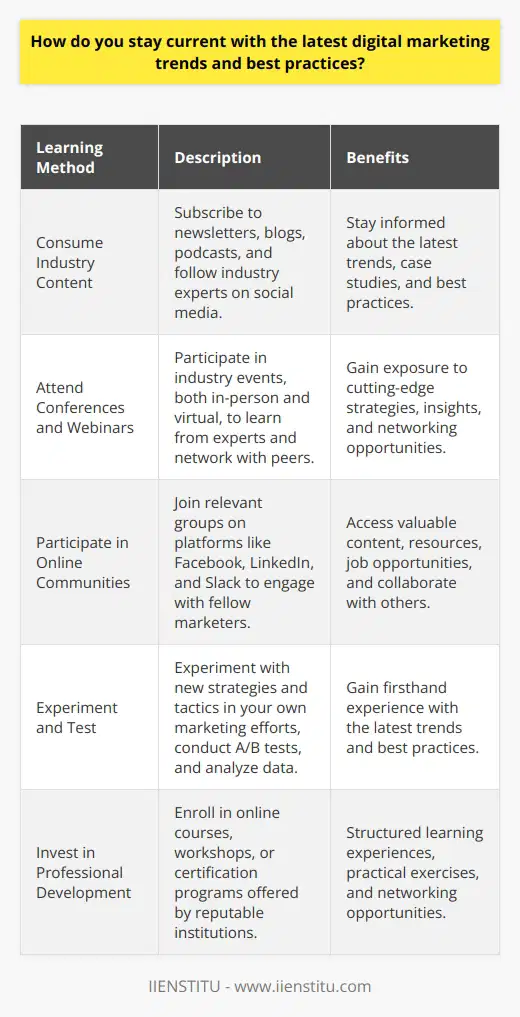
What are the main channels used in digital marketing?
Digital marketing encompasses various channels that businesses leverage to reach and engage their target audience in the digital landscape. These channels offer unique opportunities to connect with customers, build brand awareness, and drive conversions. Let's explore the main channels used in digital marketing.
Search Engine Optimization (SEO)
SEO involves optimizing websites to rank higher in search engine results pages (SERPs). By improving a website's visibility, businesses can attract more organic traffic and potential customers. SEO strategies include keyword research, content optimization, link building, and technical enhancements.
Pay-Per-Click (PPC) Advertising
PPC advertising allows businesses to display ads on search engines and other platforms. Advertisers pay each time a user clicks on their ad. Popular PPC platforms include Google Ads, Bing Ads, and social media advertising. PPC offers targeted reach, instant visibility, and measurable results.
Content Marketing
Content marketing focuses on creating and distributing valuable, relevant, and consistent content to attract and retain a target audience. Content can take various forms, such as blog posts, videos, infographics, and eBooks. The goal is to educate, inform, and engage the audience while establishing the brand as an authority.
Social Media Marketing
Social media platforms like Facebook, Instagram, Twitter, and LinkedIn provide opportunities to connect with audiences. Businesses can create engaging content, run targeted ads, and interact with followers. Social media marketing helps build brand awareness, foster customer relationships, and drive website traffic.
Email Marketing
Email marketing involves sending targeted messages to a list of subscribers. It allows businesses to nurture leads, promote products or services, and keep customers engaged. Effective email marketing campaigns deliver personalized content, offer value, and encourage recipients to take action.
Influencer Marketing
Influencer marketing leverages the reach and credibility of influencers to promote products or services. Influencers are individuals with a significant following on social media or other platforms. By collaborating with influencers, businesses can tap into their audience and gain exposure to potential customers.
Video Marketing
Video content has become increasingly popular in digital marketing. Platforms like YouTube, Instagram, and TikTok offer opportunities to create engaging video content. Videos can showcase products, provide tutorials, share customer testimonials, and entertain audiences. Video marketing can boost engagement, improve brand awareness, and drive conversions.
Affiliate Marketing
Affiliate marketing involves partnering with other businesses or individuals to promote products or services. Affiliates earn a commission for each sale or lead generated through their unique referral link. This performance-based marketing channel can help businesses expand their reach and drive sales.
To maximize the effectiveness of digital marketing, businesses should adopt a multichannel approach. By strategically combining different channels and tailoring strategies to their target audience, businesses can achieve their marketing goals and stay competitive in the digital landscape.
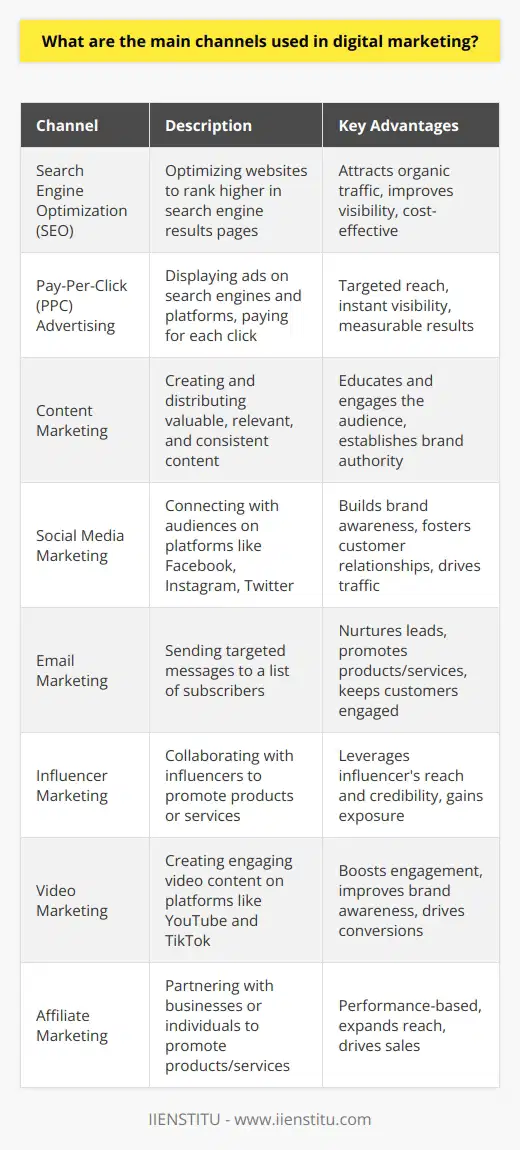
How can digital marketers effectively target their desired audience?
Digital marketers can effectively target their desired audience by employing various strategies and techniques. First, they should conduct thorough market research to identify the demographics, interests, and online behaviors of their target audience. This information can be gathered through surveys, focus groups, and analyzing customer data from previous campaigns. By understanding the characteristics and preferences of their ideal customers, marketers can create buyer personas that represent their target audience.
Utilizing Social Media Platforms
Social media platforms offer powerful targeting options that allow marketers to reach their desired audience. Marketers can use the targeting features provided by platforms like Facebook, Instagram, and LinkedIn to select users based on factors such as age, gender, location, interests, and behaviors. By creating targeted ads and content tailored to the preferences of their audience, marketers can increase the effectiveness of their campaigns and improve engagement rates.
Leveraging Remarketing Techniques
Remarketing is a valuable technique for targeting users who have previously interacted with a brand's website or content. By placing tracking pixels on their website, marketers can create remarketing lists of users who have visited specific pages or taken certain actions. These lists can then be used to serve targeted ads to those users as they browse other websites or social media platforms, reminding them of the brand and encouraging them to return and complete a desired action, such as making a purchase.
Implementing Search Engine Optimization (SEO)
Search engine optimization (SEO) is a crucial aspect of digital marketing that helps businesses attract organic traffic from search engines. By conducting keyword research and identifying the terms and phrases that their target audience uses when searching for products or services related to their business, marketers can optimize their website content, meta tags, and backlinks to improve their search engine rankings. Higher rankings for relevant keywords increase the likelihood of the target audience discovering the brand's website and engaging with its content.
Collaborating with Influencers
Influencer marketing has become an increasingly popular way for digital marketers to reach their target audience. By partnering with influencers who have a strong following within the desired demographic, marketers can leverage the influencer's credibility and reach to promote their brand, products, or services. Influencers can create sponsored content, product reviews, or brand mentions that expose the brand to their engaged audience, helping to build trust and drive conversions.
Analyzing and Refining Targeting Strategies
To ensure the effectiveness of their targeting efforts, digital marketers should continuously monitor and analyze the performance of their campaigns. By tracking metrics such as click-through rates, conversion rates, and engagement levels, marketers can gain insights into which targeting strategies are working well and which ones need improvement. Regular analysis and refinement of targeting approaches allow marketers to optimize their campaigns and allocate their resources more efficiently to reach their desired audience effectively.

Why do you want to pursue a career in digital marketing?
Pursuing a career in digital marketing is an exciting prospect for several compelling reasons. Firstly, digital marketing is a rapidly growing field that offers numerous opportunities for career advancement and professional growth. As businesses increasingly shift their focus towards online platforms, the demand for skilled digital marketers continues to rise. This trend is expected to persist, ensuring a stable and promising career path for those who choose to specialize in this area.
The Dynamic Nature of Digital Marketing
Another appealing aspect of digital marketing is its dynamic and ever-evolving nature. The digital landscape is constantly changing, with new technologies, platforms, and strategies emerging on a regular basis. This fast-paced environment presents a stimulating challenge for professionals who thrive on staying ahead of the curve and adapting to new trends. Digital marketers have the opportunity to continuously learn and develop their skills, ensuring that their knowledge remains relevant and valuable in an increasingly competitive market.
The Opportunity to Make a Tangible Impact
Digital marketing also offers the chance to make a tangible impact on businesses and their success. By leveraging various digital channels and tactics, marketers can help companies reach their target audiences, build brand awareness, and drive conversions. The ability to measure and analyze the effectiveness of marketing campaigns through data-driven insights allows for continuous optimization and improvement. This direct connection between effort and results is highly satisfying, as it enables marketers to see the fruits of their labor and contribute to the growth of the organizations they serve.
The Versatility of Digital Marketing Skills
Furthermore, the skills acquired in digital marketing are highly versatile and transferable across industries. Whether working for a small startup, a large corporation, or even as a freelancer, the fundamental principles of digital marketing remain applicable. This versatility opens up a wide range of career paths and opportunities, allowing professionals to explore different sectors and find their niche. From content creation and social media management to search engine optimization and email marketing, there are numerous specializations within the field to suit various interests and strengths.
The Collaborative and Creative Environment
Lastly, the digital marketing industry fosters a collaborative and creative environment that is both challenging and rewarding. Digital marketers often work closely with cross-functional teams, including designers, developers, and sales professionals, to create cohesive and effective campaigns. This collaborative spirit encourages the exchange of ideas, knowledge sharing, and the opportunity to learn from diverse perspectives. Additionally, digital marketing allows for a great deal of creativity, as professionals can experiment with different strategies, content formats, and visual elements to captivate and engage audiences.
In conclusion, pursuing a career in digital marketing is an attractive choice for those seeking a dynamic, impactful, and versatile profession. With its rapid growth, constant evolution, and collaborative nature, digital marketing offers a fulfilling career path that combines creativity, analytical thinking, and the ability to drive meaningful business results. As the digital landscape continues to expand, the opportunities within this field are bound to multiply, making it an exciting time to embark on a career in digital marketing.

What aspects of digital marketing do you find most appealing and why?
Digital marketing offers a plethora of appealing aspects that make it an exciting and dynamic field. One of the most attractive features is its ability to reach a vast audience with targeted precision. By leveraging data analytics and user behavior insights, digital marketers can deliver personalized messages to specific demographics, ensuring higher engagement and conversion rates. This level of targeting is unparalleled in traditional marketing methods and allows businesses to optimize their marketing spend effectively.
The Power of Measurability
Another compelling aspect of digital marketing is its measurability. Unlike traditional marketing channels, digital platforms provide real-time data and metrics that allow marketers to track the performance of their campaigns. This data-driven approach enables quick adjustments and optimizations based on user responses, leading to better results and ROI. The ability to measure and attribute success to specific marketing efforts is invaluable for businesses looking to maximize their marketing investments.
Engaging Across Multiple Channels
Digital marketing also offers the opportunity to engage with audiences across multiple channels. From social media platforms to email campaigns and mobile apps, marketers can reach customers where they spend most of their time. This multi-channel approach allows for a more holistic and integrated marketing strategy, creating a seamless brand experience for consumers. By leveraging the strengths of each channel, businesses can build stronger relationships with their target audience and drive better results.
The Creative Playground
The digital landscape provides a creative playground for marketers to explore and innovate. With the constant emergence of new technologies and platforms, there are endless opportunities to create compelling and interactive content. From immersive videos and augmented reality experiences to gamified campaigns and user-generated content, digital marketing allows brands to push the boundaries of creativity and engage audiences in fresh and exciting ways. This creative freedom is what makes digital marketing a thrilling and ever-evolving field.
Cost-Effective and Agile
Compared to traditional marketing methods, digital marketing is often more cost-effective and agile. With lower entry barriers and the ability to scale campaigns quickly, businesses of all sizes can compete in the digital space. Digital marketing allows for real-time adjustments and optimizations, enabling marketers to respond to market trends and consumer behavior swiftly. This agility is crucial in today's fast-paced business environment, where staying relevant and adaptable is key to success.
In conclusion, digital marketing's appeal lies in its ability to deliver targeted, measurable, and engaging campaigns across multiple channels. Its data-driven approach, creative possibilities, cost-effectiveness, and agility make it an indispensable tool for businesses looking to thrive in the digital age. As technology continues to evolve, the potential for innovation and growth in digital marketing is boundless, making it an exciting and rewarding field to be a part of.

How do you believe your skills and experiences align with the requirements of a digital marketing role?
My skills and experiences align well with the requirements of a digital marketing role. I have a strong foundation in marketing principles and a keen understanding of digital marketing strategies. Through my education and internships, I have gained practical experience in various aspects of digital marketing, including social media management, content creation, and data analysis.
Strong Communication Skills
I possess excellent communication skills, both written and verbal, which are essential for creating compelling marketing messages. I have honed my writing skills through courses in copywriting and content creation, enabling me to craft engaging and persuasive content for different platforms and audiences. Additionally, my experience in collaborating with cross-functional teams has strengthened my ability to communicate effectively and work towards common goals.
Analytical Mindset
I have a data-driven approach to marketing, and I am skilled in using analytics tools to measure campaign performance. My coursework in marketing analytics has provided me with a solid understanding of how to interpret data and derive actionable insights. I am comfortable working with various analytics platforms, such as Google Analytics, to track key metrics and optimize marketing efforts based on data-driven decisions.
Social Media Proficiency
I am well-versed in managing social media accounts and creating engaging content for different platforms. Through my internships, I have gained hands-on experience in developing and executing social media strategies, creating content calendars, and monitoring social media metrics. I stay up-to-date with the latest social media trends and best practices to ensure that I can effectively reach and engage target audiences.
Content Creation Skills
I have a creative mindset and a passion for creating compelling content across various formats, including blog posts, infographics, and videos. My experience in content creation has taught me how to develop content that resonates with target audiences and aligns with brand messaging. I am skilled in using content management systems and have a good understanding of SEO principles to optimize content for search engines.
Adaptability and Continuous Learning
The digital marketing landscape is constantly evolving, and I am committed to staying updated with the latest industry trends and technologies. I am a quick learner and have a proactive approach to acquiring new skills and knowledge. I regularly attend webinars, read industry blogs, and participate in online courses to expand my digital marketing expertise.
Collaboration and Leadership
I thrive in collaborative environments and have experience working in cross-functional teams. Through group projects and internships, I have developed strong teamwork and leadership skills. I am comfortable taking initiative, delegating tasks, and contributing to the overall success of marketing campaigns. I believe in fostering a positive team dynamic and working together to achieve common objectives.
In conclusion, my skills and experiences, including strong communication abilities, analytical mindset, social media proficiency, content creation skills, adaptability, and collaborative nature, make me a strong candidate for a digital marketing role. I am excited about the opportunity to apply my knowledge and skills to contribute to the success of a dynamic marketing team.
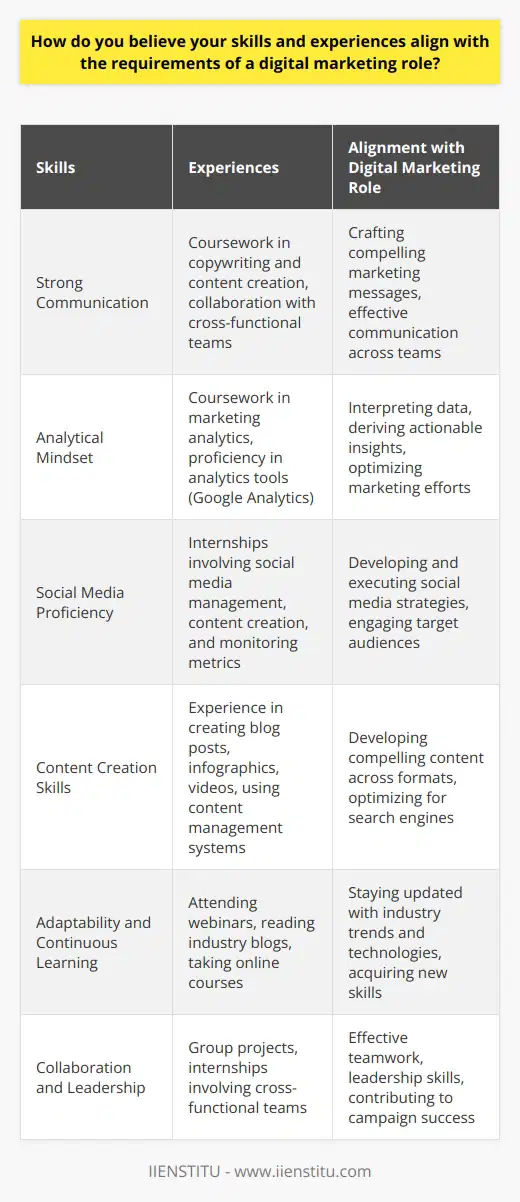
What are some common challenges faced in digital marketing campaigns?
Digital marketing campaigns often encounter various challenges that can hinder their effectiveness and success. One common challenge is targeting the right audience. With the vast amount of digital platforms and channels available, it can be difficult to identify and reach the most relevant and valuable audience for a particular product or service. Marketers need to conduct thorough research and utilize data-driven insights to develop targeted strategies that effectively engage their desired audience.
Budget Constraints and ROI Measurement
Another challenge faced in digital marketing campaigns is budget constraints. Digital marketing requires investment in various aspects such as advertising, content creation, and technology. Balancing the allocation of limited resources across different channels and tactics can be challenging. Marketers must prioritize their initiatives based on potential return on investment (ROI) and continuously monitor and adjust their spending to optimize campaign performance.
Measuring the ROI of digital marketing campaigns can also be a complex task. With multiple touchpoints and attribution models, it can be difficult to accurately determine the impact of individual marketing efforts on overall business objectives. Marketers need to establish clear metrics and tracking mechanisms to assess the effectiveness of their campaigns and make data-driven decisions for optimization.
Adapting to Changing Consumer Behavior and Technology
The digital landscape is constantly evolving, and consumer behavior and preferences change rapidly. Keeping up with these changes and adapting marketing strategies accordingly can be challenging. Marketers must stay updated with the latest trends, platforms, and technologies to remain relevant and effective in their campaigns. This requires continuous learning, experimentation, and a willingness to embrace new approaches.
Ad Fatigue and Banner Blindness
Ad fatigue and banner blindness are common challenges in digital advertising. Consumers are increasingly bombarded with advertisements across various digital platforms, leading to a decrease in engagement and effectiveness. Marketers must develop creative and compelling ad content that stands out and captures attention. Personalization and relevance are key factors in overcoming ad fatigue and ensuring that messages resonate with the target audience.
Content Creation and Optimization
Creating high-quality, engaging, and shareable content is crucial for the success of digital marketing campaigns. However, producing a consistent stream of valuable content can be resource-intensive and time-consuming. Marketers must strike a balance between quantity and quality, ensuring that their content aligns with their brand's voice, target audience's preferences, and marketing objectives. Optimization of content for search engines and social media algorithms is also essential to improve visibility and reach.
Data Privacy and Security Concerns
With the increasing importance of data in digital marketing, concerns about data privacy and security have become more prevalent. Marketers must navigate complex regulations and ensure compliance with data protection laws such as GDPR and CCPA. Building trust with consumers by being transparent about data collection and usage practices is essential. Implementing robust security measures to safeguard customer data from breaches and cyber threats is also a critical responsibility for digital marketers.
To overcome these challenges, digital marketers need to adopt a data-driven and customer-centric approach. Continuously monitoring campaign performance, gathering customer insights, and iterating strategies based on feedback and results are essential practices. Collaboration with cross-functional teams, including IT, creative, and analytics, can help address technical and content-related challenges. By staying agile, adaptable, and focused on delivering value to customers, digital marketers can navigate the challenges and achieve successful outcomes in their campaigns.
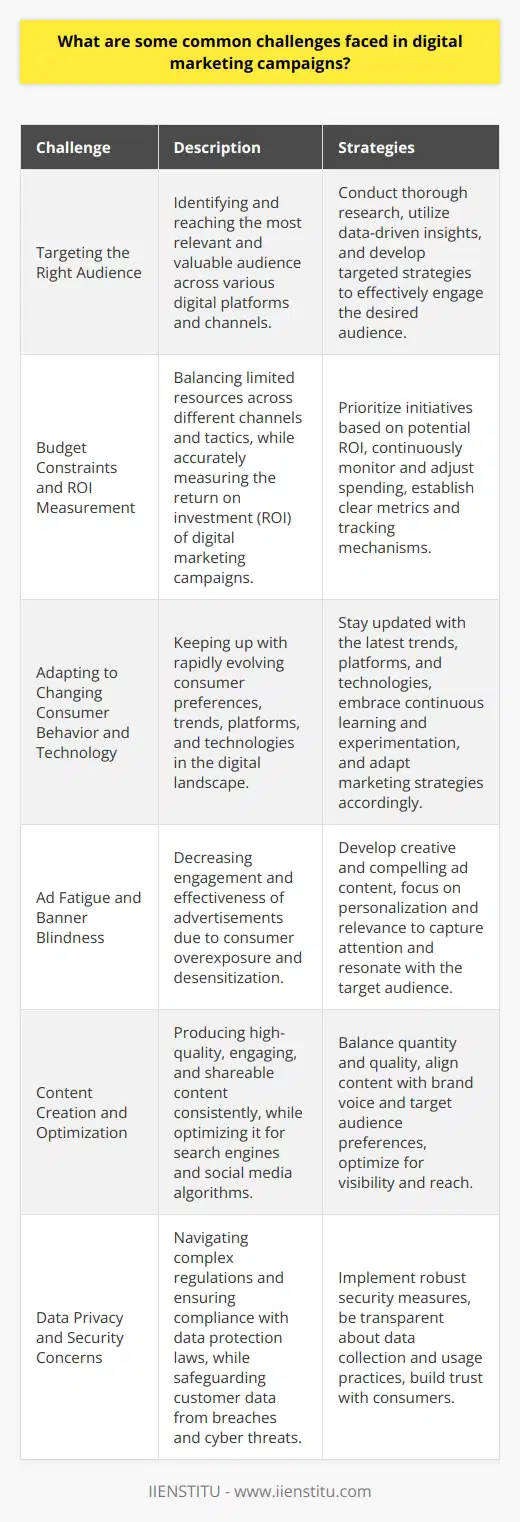
How can a company effectively measure the ROI of its digital marketing efforts?
Measuring the ROI of digital marketing efforts is crucial for companies to optimize their marketing strategies and budgets. To effectively measure ROI, companies should start by setting clear and measurable goals for their digital marketing campaigns. These goals should align with the company's overall business objectives and be specific, measurable, achievable, relevant, and time-bound (SMART).
Next, companies should identify the key performance indicators (KPIs) that will help them track progress towards their goals. Some common KPIs for digital marketing include website traffic, lead generation, conversion rates, and customer acquisition costs. By monitoring these KPIs regularly, companies can gain insights into the effectiveness of their digital marketing efforts and make data-driven decisions to optimize their strategies.
Tracking and Analyzing Data
To accurately measure ROI, companies must have robust tracking and analytics systems in place. This includes implementing tracking codes on their websites and using tools like Google Analytics to monitor user behavior and engagement. Companies should also track the performance of their digital marketing campaigns across various channels, such as social media, email, and paid advertising.
Attribution Modeling
Attribution modeling is another important aspect of measuring digital marketing ROI. This involves determining which touchpoints along the customer journey contributed to a conversion or sale. By using attribution models, companies can better understand the impact of each marketing channel and allocate their budgets accordingly.
Calculating ROI
Once companies have collected and analyzed their data, they can calculate the ROI of their digital marketing efforts. The basic formula for calculating ROI is (Revenue - Cost) / Cost x 100. However, companies should also consider other factors, such as the lifetime value of a customer and the long-term impact of brand awareness and loyalty.
A/B Testing and Optimization
To continuously improve their digital marketing ROI, companies should regularly conduct A/B tests and optimize their campaigns based on the results. This involves testing different versions of ad copy, landing pages, and other elements to determine which performs best. By continuously refining their strategies based on data and insights, companies can maximize the ROI of their digital marketing efforts.
Reporting and Communication
Finally, companies should regularly report on the ROI of their digital marketing efforts to stakeholders and decision-makers. This includes creating clear and concise reports that highlight key metrics, insights, and recommendations. By communicating the value and impact of digital marketing, companies can secure buy-in and investment for future campaigns and initiatives.
Conclusion
Measuring the ROI of digital marketing is an ongoing process that requires careful planning, tracking, analysis, and optimization. By setting clear goals, monitoring KPIs, using attribution modeling, calculating ROI, conducting A/B tests, and regularly reporting on results, companies can effectively measure and maximize the ROI of their digital marketing efforts.
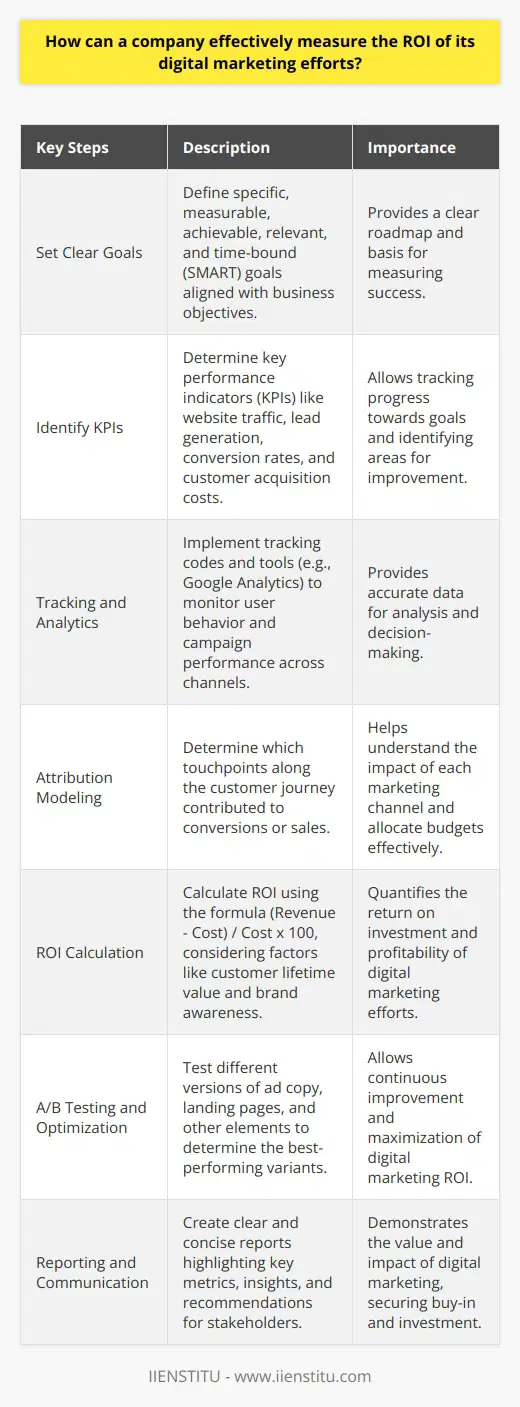
What strategies would you recommend for improving a brand's online presence and engagement?
Improving a brand's online presence and engagement requires a multifaceted approach that encompasses various strategies. These strategies should focus on creating valuable content, optimizing for search engines, leveraging social media, and fostering community interaction. By implementing these tactics effectively, brands can enhance their visibility, attract their target audience, and build lasting relationships with their customers.
Create Valuable and Engaging Content
One of the most crucial aspects of improving a brand's online presence is creating valuable and engaging content. This content should be relevant to the brand's niche and provide useful information to its target audience. Brands should invest in developing a content strategy that includes blog posts, videos, infographics, and other forms of media that resonate with their customers.
Optimize Content for Search Engines
To ensure that the brand's content reaches its intended audience, it is essential to optimize it for search engines. This involves conducting keyword research to identify relevant terms and phrases that potential customers might use when searching for products or services related to the brand. By incorporating these keywords strategically into the content, brands can improve their search engine rankings and increase their visibility online.
Leverage Social Media Platforms
Social media platforms provide an excellent opportunity for brands to connect with their target audience and engage with them on a personal level. Brands should establish a strong presence on relevant social media channels and regularly post content that encourages interaction and sharing. This can include asking questions, running contests, and sharing user-generated content.
Engage with Your Audience
Engaging with your audience is crucial for building relationships and fostering loyalty. Brands should actively monitor their social media channels and respond to comments, questions, and feedback in a timely and professional manner. This shows that the brand values its customers' opinions and is committed to providing excellent customer service.
Collaborate with Influencers
Collaborating with influencers in your niche can help expand your brand's reach and attract new followers. Identify influencers who align with your brand's values and have a dedicated following. Engage them to create sponsored content or review your products, which can expose your brand to a wider audience and build trust.
Encourage User-Generated Content
User-generated content (UGC) is a powerful tool for building brand awareness and engagement. Encourage your customers to share their experiences with your products or services on social media, and feature their content on your channels. This not only provides social proof but also creates a sense of community around your brand.
Implement Email Marketing
Email marketing is an effective way to keep your audience engaged and informed about your brand. Build an email list by offering valuable content or incentives for subscribers. Send regular newsletters that provide updates, promotions, and exclusive content to keep your subscribers engaged and drive traffic to your website.
Monitor and Analyze Metrics
To continually improve your brand's online presence and engagement, it is crucial to monitor and analyze relevant metrics. Use tools like Google Analytics and social media analytics to track website traffic, engagement rates, and conversions. This data can help you identify what strategies are working well and where improvements can be made.
By implementing these strategies and consistently creating valuable content, brands can improve their online presence and engagement. Remember that building a strong online presence takes time and effort, but the rewards of increased visibility, customer loyalty, and business growth make it a worthwhile investment.
